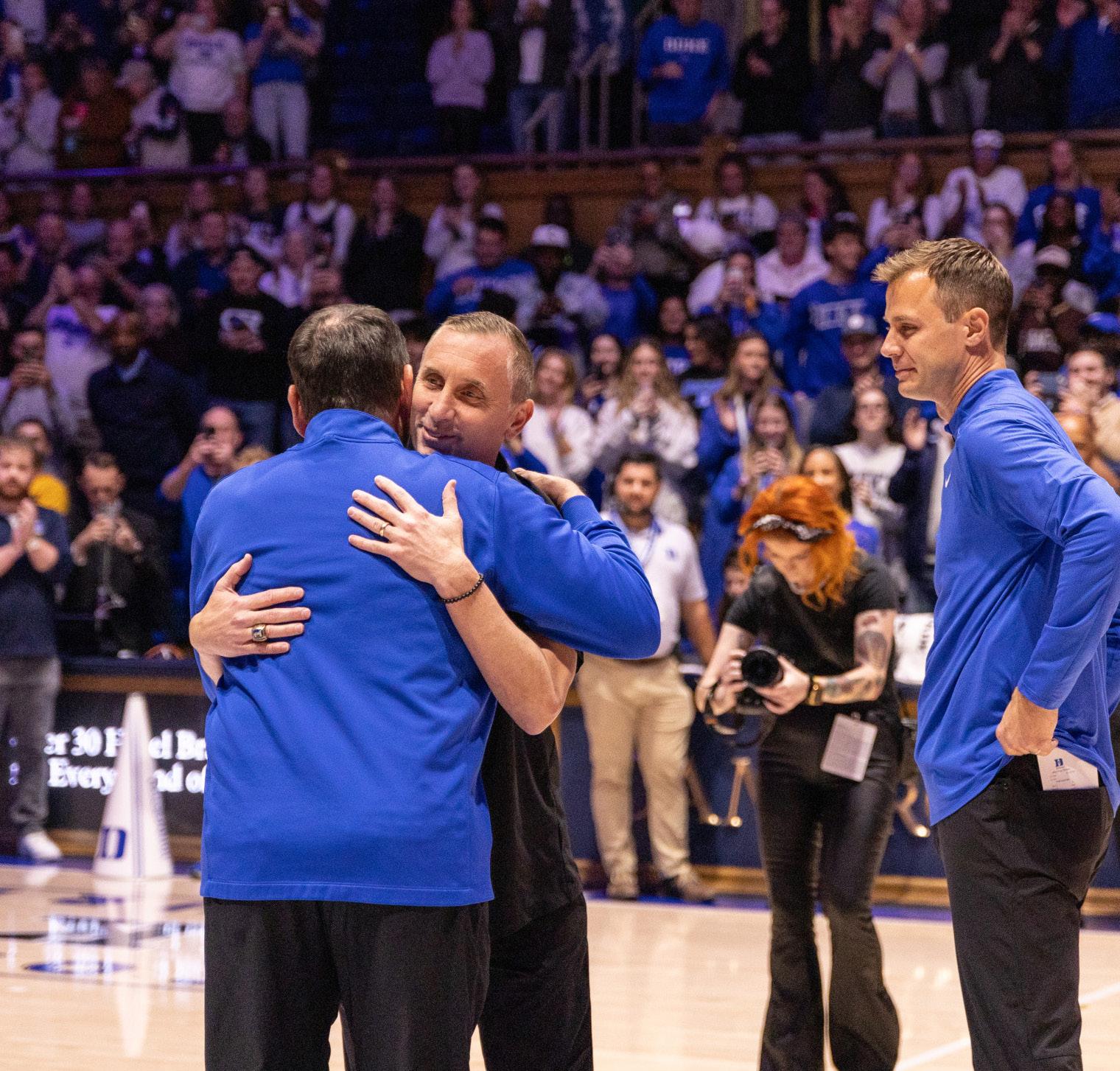






































By Rodrigo Amare Assistant Blue Zone Editor
Duke men’s basketball owns a spot in the national spotlight, yet the 2024-25 Blue Devils are poised to receive a nearly unprecedented amount of attention. Viewership of even nonconference games will likely skyrocket. The team’s performance will be discussed in circles that traditionally overlook college basketball. Coaches and players alike will be scrutinized for any mistake, glorified for every success.
Freshman forward Cooper Flagg’s commitment to Duke last October forever changed the narrative surrounding head coach Jon Scheyer’s third year at the helm. As the consensus No. 1 recruit in the nation and first freshman to be named Preseason All-American
in four years, Flagg begins this season with an avalanche of expectations on his back.
“I don’t know if we’ve ever had a 17-yearold with as much attention around him,” Scheyer said in a September media availability.
“A lot of it rightfully so, [because of] the high school career he’s had and what he’s done.”
The national spotlight would have undoubtedly fixated on Flagg based on the merits of his high school career alone; few teenagers can boast about a 33-0 senior season, a national championship and National High School Player of the Year recognition.
But the excitement around the Newport, Maine, native truly exploded after videos circulated of Flagg training against the USA Men’s National Team before the Olympics. After all, playing on the same court as LeBron
James and Steph Curry, swishing threes over the top of former Blue Devil Brandon Ingram and finishing through contact against fivetime NBA All-Defensive Team selection Bam Adebayo are not your typical 17-year-old summer activities.
“I was out in Vegas during the scrimmage,” Duke associate head coach Chris Carrawell said. “You had LeBron, Steph and Tatum and all these guys out there, and for a three-minute stretch, [Flagg] was the best player on the floor. It wasn’t [just] the fact that he played well. It was the fact that if you didn’t know who he was, you would have said ‘Oh, who’s that guy? He plays for the Raptors, right?’ He just looks like those guys physically.”
The hype surrounding Flagg has inevitably drawn comparisons to Zion Williamson’s
2018-19 campaign with the Blue Devils. Besides earning National Player of the Year and consensus first-team All-American honors, Williamson’s jaw-dropping displays of sheer athleticism captivated the nation. Celebrities like acclaimed movie director Spike Lee, MLB Hall of Famer Ken Griffey Jr. and even former President Barack Obama flocked to Cameron Indoor Stadium just to catch a glimpse of the Spartanburg, S.C., native in Duke Blue. Flagg is widely projected to follow in Williamson’s footsteps and be selected first overall in next year’s NBA Draft, even before he’s played a single official minute of college basketball. Yet, the comparisons between Flagg and Williamson should end there. Not only are they two completely distinct players, but each arrived in Durham under wildly different circumstances.

It’s worth remembering that before Williamson’s first and only campaign with the Blue Devils, the New Orleans Pelicans star was not even considered the best freshman on the roster. That distinction went to current Toronto Raptors guard R.J. Barrett, the consensus No. 1 recruit in the nation and highest-ranked Duke prospect until Flagg’s commitment.
Williamson only cemented himself as the Blue Devils’ most anticipated star after the team began its preseason activities.
“After we got back from our foreign tour in Canada, it was ‘Zion Mania,’” Carawell remembered. “At that point I had been around Duke since 1996 … but I had never seen anything like Zion. He was incredible and everybody wanted to be around him.”
It would be wrong to overlook the freshman’s physical gifts; Flagg’s 6-foot-9 frame, 40-inch vertical and impressive athleticism make him a formidable force even without the added intangibles. What’s more, the forward’s ball handling and shooting abilities, while still developing, are both exceptional for someone his size.
You had LeBron, Steph and Tatum and all these guys out there, and for a threeminute stretch, [Flagg] was the best player on the floor.
Chris
“I won’t say Cooper is at [Zion’s] level yet, but when a non-basketball fan at the grocery store asks [about] ‘that Cooper Flagg guy’, and you’re like ‘you don’t watch basketball everyday,’ … that’s how you know the interest [is there],” he said.
The furious frenzy surrounding Williamson arose mostly as a result of his thunderous dunks, ferocious blocks and electrifying style of play. Conversely, the excitement around Flagg stems mostly from his all-around game and potential as an NBA prospect. He isn’t as flashy as Williamson; Flagg’s strengths are much more subtle and his impact on the court stretches far beyond what appears on a highlight reel.
However, it’s the little things Flagg excels at, particularly on the defensive end, which truly differentiate him from other highlytouted recruits. Scheyer aptly described the importance of Flagg’s intangible attributes.
“The first thing for me is his competitiveness all the time. When you see a guy that doesn’t turn his competitiveness on and off, he doesn’t turn on and off how hard he works, [that] stands out to you,” he said. “The second thing is his feel. He prides himself on knowing the game, on picking things up right away … You just have to tell him once, and then he’s got it.”
Boasting elite defensive instincts, an uncanny shot-blocking ability and an intensity and ferocity reminiscent of the very best defenders to play the game, Flagg projects as a nightmarish matchup for even the best scorers. The Blue Devil forward also possesses an unteachable knack for making the right pass or taking the right shot, to the great benefit of both himself and his teammates.
However, the Montverde Academy product is not yet a finished product offensively, so Flagg probably won’t average near 22.6 points per game or shoot 68% from the field, as Williamson did with Duke. It’s possible Flagg won’t even



be the Blue Devils’ leading scorer, which harps back to the second thing comparisons between Flagg and Williamson miss.
While Williamson, alongside Barrett, was largely entrusted to bear the bulk of Duke’s offensive responsibility on an extremely top-heavy squad, Scheyer’s 2024-25 team is perfectly constructed to relieve that pressure from Flagg’s shoulders. Returning guards Tyrese Proctor and Caleb Foster each bring elite playmaking to the fold, while the rest of Scheyer’s freshman class features a cornucopia of elite 3-point shooters, each more than capable of both spacing the floor and lighting up the scoreboard. As such, Flagg will be free to flourish in every aspect of his game beyond what jumps out on the box score.
Duke’s 103-47 exhibition rout of Arizona State Sunday illustrated this point; Despite only amassing nine points on the night, Flagg delivered a stout defensive performance while creating numerous opportunities for his teammates to shine offensively, resulting in a 56-point victory and a staggering +34 plusminus for the Newport native.
The Blue Devils will likely face some setbacks this year, sprouting reactionary narratives that are as easy to predict as they will be flawed in nature. If Scheyer’s squad loses a game in which Flagg does not impress offensively, opposing fans and journalists will scramble to their keyboards, eager to label the freshman overrated and a mere product of the Duke media machine. But if these critics truly pay attention to Flagg’s performances, they will realize searching for Flagg’s impact purely on the statsheet grossly oversimplifies what makes him one of the most anticipated prospects in recent memory.
“Very soon, we’re going to be playing national T.V. games outside of Cameron,” Scheyer said.
“I can tell you Cooper’s wired for it, just like Zion was. I think the thing everybody should understand is he’s still 17, going through an incredibly difficult schedule [with] a lot on his shoulders. There’s gonna be moments where he has growing pains … It’s par for the course. He’s gotta control the things he can control.”
The gargantuan expectations surrounding Flagg this season, while not undeserved, may be misplaced. If Williamson was akin to a blockbuster movie, easily palatable and immensely marketable, Flagg compares more favorably to a timeless classic. One is not necessarily better than the other, but modern audiences may struggle to appreciate the latter. Flagg, for one, has adopted a clever perspective to deal with the cacophony of attention and scrutiny he has already begun to receive.
“As far as hype goes, I think that’s something you learn to deal with,” Flagg said in September. “And for me it’s just about playing basketball … There’s always eyes everywhere we’re going on campus. When we first got here some of the students even were kind of going crazy. But to me, it’s just like a compliment in a way. It shows all the hard work that you’ve put in over time.”
Blue Devil fans should get excited about both Flagg and the team’s chances of capturing a sixth national title this year. With a bonafide superstar in Flagg and a roster loaded at every position, there’s no limit to what Duke can accomplish. However, the Cameron Crazies should reframe their expectations about what the freshman brings to the table. Cooper Flagg is not the next Zion Williamson. Don’t expect a flurry of 360-degree dunks and 20-plus point-per-game performances. Instead, watch closely for Flagg’s impact on every aspect of the game, and you won’t be disappointed with what you find.

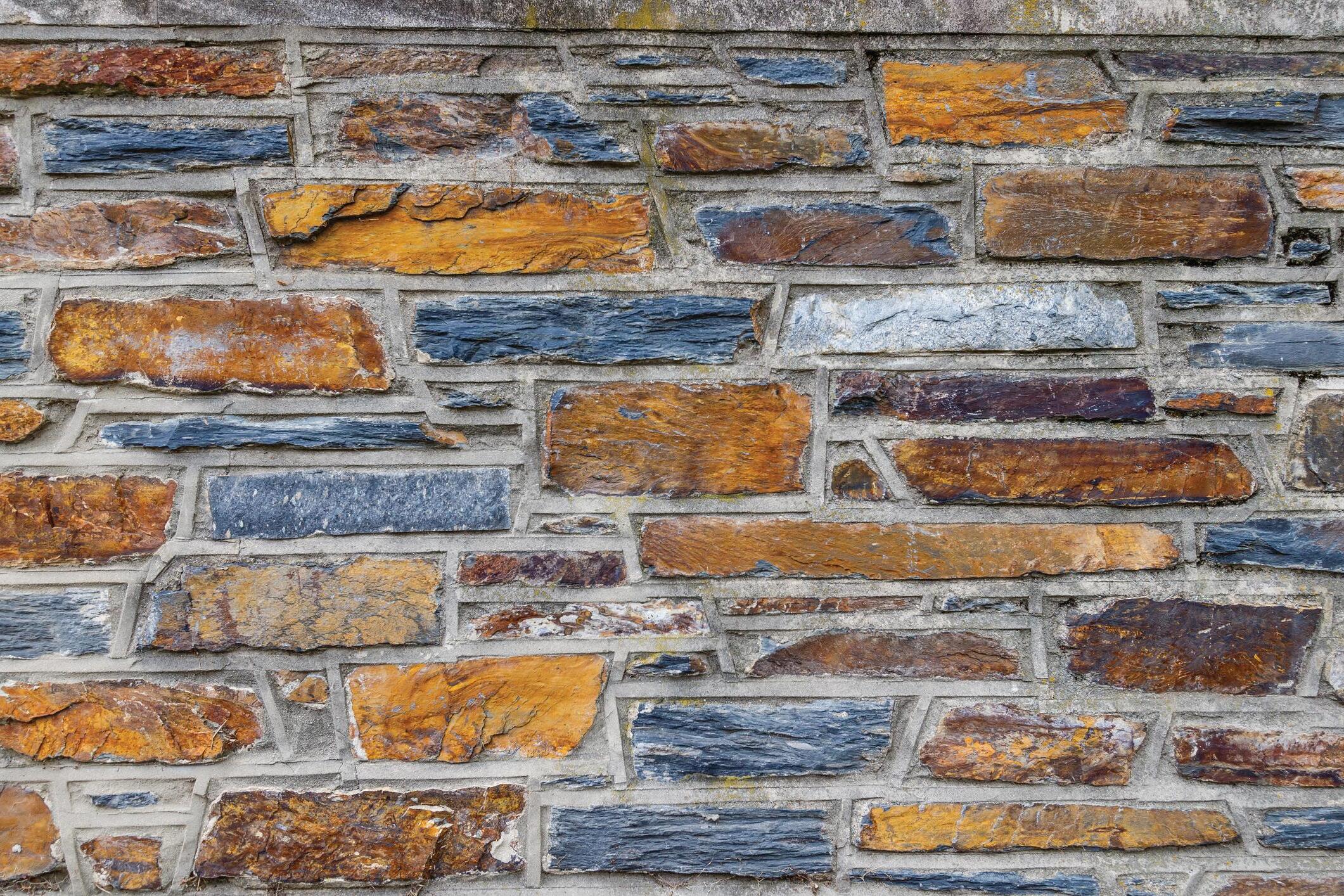



By Sophie Levenson Sports Managing Editor
Bobby Hurley isn’t used to losing in Cameron Indoor Stadium, but he’ll do it for a good cause.
In a Devil-off Sunday evening, Duke men’s basketball welcomed Hurley’s Arizona State squad to Durham for a Brotherhood Run charity exhibition game, benefitting the Duke Children’s Hospital. The Blue Devils, however, were anything but charitable on the court, and kept the ball away from their visitors to finish their exhibition series with a gaping 103-47 victory.
“They just busted their butts,” said head coach Jon Scheyer after the game. “You
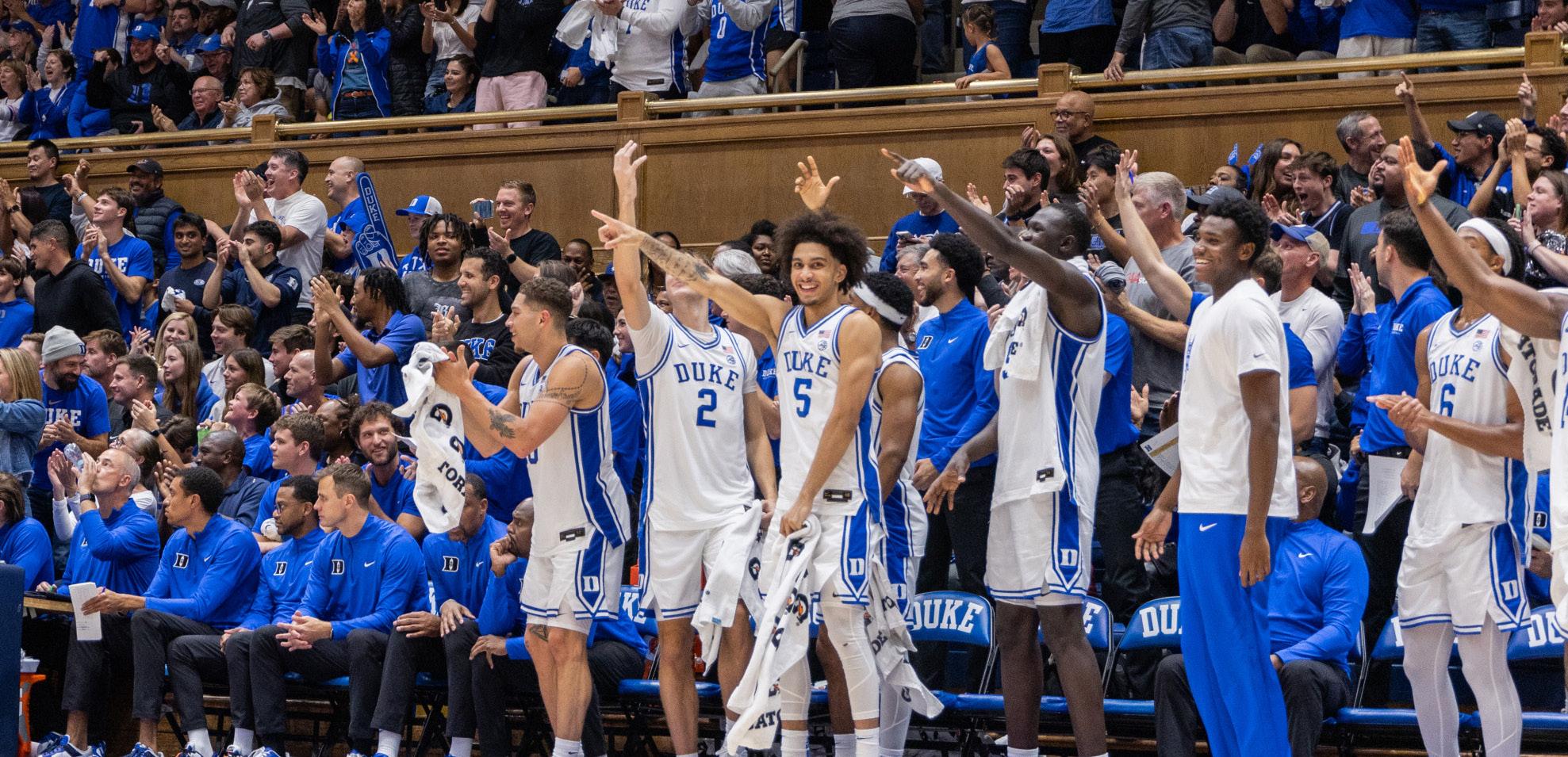
can make up for a lot if you’re giving it all you’ve got.” Not that Duke had much to make up for.
The fourth minute of the second half put Cameron Indoor Stadium in a frenzy. Freshman guard Kon Knueppel sent a ball with perfect arc through Arizona State’s rim, and the crowd exploded onto its feet for the rookie’s second triple of the half. The buzzer rang for a timeout and LMFAO’s “Shots” filled the waiting period for the Crazies. The game had barely resumed when freshman forward Cooper Flagg caught a long-range pass from a wicked Tyrese Proctor steal that he slammed through the rim for a dunk.
Twenty-two seconds later, Knueppel took one from the top of the arc while a Sun
Devil knocked him to his feet — it went in anyway. He made it a 4-pointer at the stripe. Twenty seconds later, the Wisconsin native passed over glory to Proctor, throwing his captain the assist for a triple of his own.
By the time Basheer Jihad finally scored for Arizona State, Duke had completed a 15-0 run and led 56-24. Duke fans waited for under a minute before Knueppel stole the ball from a Sun Devil and swished another three.
“He’s one of the best guys in the country,” Proctor said of Knueppel.”When he’s hot, we’ve got to keep finding him. He’s confident, he puts the work in and he’s gonna make it.”
After all that, Knueppel deferred to his teammates. He took to the bench for an
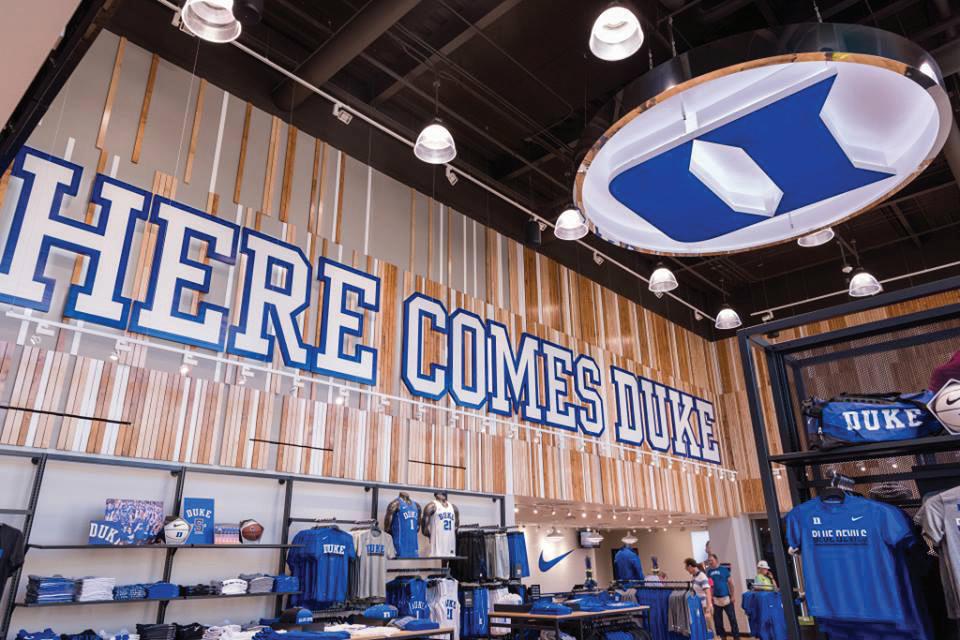
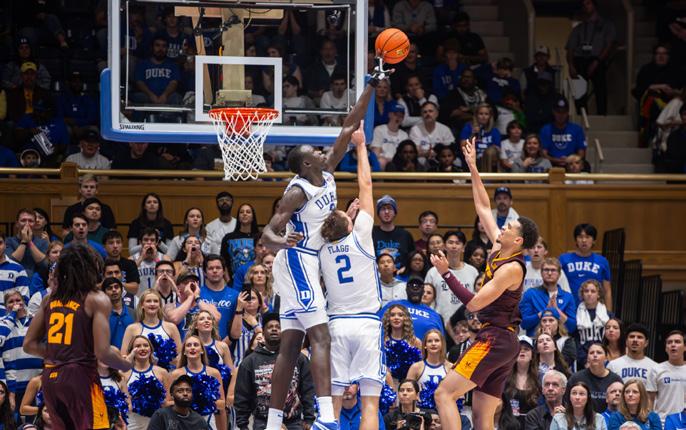
up-close view of the 3-point circus that his fellow Blue Devils were about to play out, spearheaded by graduate transfers Mason Gillis and Sion James. With Proctor and Foster on the bench, James took over point for Duke, Gillis by his side. The wellseasoned duo took turns launching triples, as James knocked down 3-of-4 and Gillis completed 2-of-3. They let Isaiah Evans and Darren Harris get involved too — why not share the wealth? — so that both guards scored from downtown.
“It was a chance for us to really get rolling as a team,” James said. All together, Duke went 15-of-23 from the arc in the second period.
See EXHIBITION on Page 19

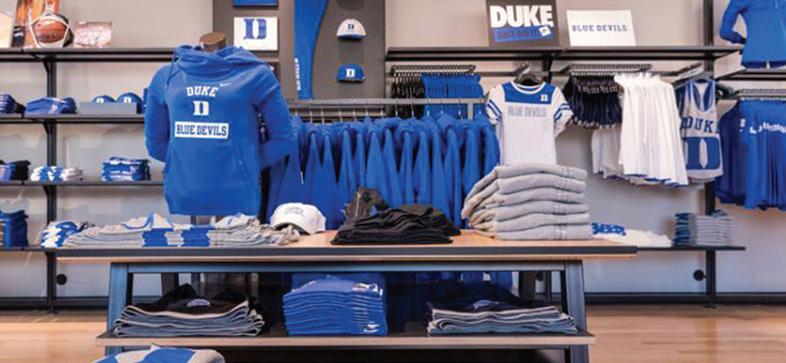
For a unique shopping experience, visit us in our 4,200 square foot facility located in the Scott Family Athletics Performance Center on Tribull Plaza between Cameron Indoor Stadium and Brooks Field at Wallace Wade Stadium in the Duke Athletics Campus. The Duke Team Store is the perfect place for Duke fans to shop the best selection of Nike game day clothing, headwear and accessories.
Please note: For Football & Men’s Basketball games, the Team Store will be open 2 hours before the game and 1 hour after the game ends. For Women’s Basketball games, the Team Store is open 2 hours before the game and 30 minutes after the game ends.
Scott Famly Athletics Performance Center | 919.684.1347
Monday: CLOSED | Tuesday - Saturday: 10am - 6pm | Sunday: 1pm - 5pm https://www.dukestores.duke.edu/index.php/team-store/


By Caleb Dudley Associate Editor
“I’ve got another one for you.”
When Duke head coach Jon Scheyer hears those words from Glenn Farello, he takes them seriously. This is a line high school basketball coaches say a lot, but from the head coach of St. Paul VI’s (PVI), it reflects a deep trust in an emerging pipeline between the prep school and the Duke Brotherhood.
In current Duke freshman Darren Harris’ first year of high school, Farello delivered that line to then-assistant coach Scheyer. Now, Harris and fellow freshman Patrick Ngongba II carry on a tradition in Durham that they shared throughout high school and AAU ball.
the name of Jeremy Roach, with the future star Blue Devil point guard unknowingly setting off a recruiting stretch that has allowed PVI to feed talent down to Durham ever since.
Before this connection was established, Roach’s recruitment was handled just like any other top prospect, fielding visits from coaches around the nation and hearing the pitch of countless top programs.
“Coach Scheyer and Coach K recruited Jeremy, and obviously did a great job of building that relationship and connection with him and so he made a decision to go,” Farello said.
We’ll randomly be like, it’s crazy how we’re both here … He’s like a brother to me.
“That duo … I thought that they complemented each other very well on the floor, but personality wise, I think they’re just good kids, man. I mean, they’re great teammates,” Farello told The Chronicle.
Some kids grow up as fans of the Blue Devils and dream of taking the floor at Cameron Indoor Stadium. It just so happened that PVI had one of these dreamers in its program, a year behind Roach. Trevor Keels’ coach made sure that he introduced him to Duke’s top staff.
Darren Harris Duke guard
“I think at some point you’re gonna want to recruit him,’” Farello told Krzyzewski.
until his junior year and had a much more open recruitment than his teammate.
Harris stayed in his teammate’s ear during his recruiting process, hoping to continue their connection at the college level. While Scheyer needs no help on the recruiting trail, Harris was able to provide an assist on this one.
“I remember when he first started to come into his own. Coach Scheyer hit me up and was like, ‘What do you think of him, how is he?’ And I said nothing but good things and it kind of took off from there,” Harris said.
When the dust settled, both capitalized on the connection between the two schools. Ngongba and Harris moved from Farello’s tutelage to Scheyer’s.
Countless basketball prep schools have elite players year in and year out, but there’s something special, for Scheyer, about PVI.
Farello is intentional about the way he runs his program. He is not naive enough to think that his players only have PVI in their minds when it comes to their basketball careers. Instead of letting this bother him, he wants PVI to emulate a college program to the best of its ability.
But college athletics is not just about what happens on the court. Between classes, film sessions and new NIL-related activities, the grind does not stop for basketball players when they walk out of the gym. Farello is not oblivious to this, and this mental development is at the top of his mind as he works to mold his young players into future successful collegiate players.
“We do sessions on character and leadership. We do a lot of film study that really breaks things down. We introduce so many college concepts and show college clips to say, ‘This is what we’re trying to get you guys ready for.’” Farello said. “It’s important to me, when guys first get to PVI, we’re already talking about college, it’s a stepping stone.”
For Harris and Ngongba, the way Farello ran the show paralleled the way Scheyer and company handle business, as the pair remarked about the similarities between the two schools at the end of their respective recruiting processes.
“Duke just seems like the perfect place for me as a player and person. On the court, I think the fit is perfect, they have a great history of elite shooters and wing scorers. Off the court, it’s one of the best universities in the world,” Harris told 247Sports at the end of his recruitment.
“Sometimes you forget how close we are. We’ll randomly be like, it’s crazy how we’re both here … He’s like a brother to me,” Harris said about Ngongba.
It is not unusual for college programs to recruit routinely well in one area of the nation, drawing on geographic proximity or coaching relationships to attract top regional talent to their school. But four players in the last five years all attending Duke from one school? That’s a different level.
Located in Chantilly, Va., PVI is one of the premier basketball high schools in the country. Over the last 20 years, it has been a constant presence on the national scene, with the 202324 team finishing the season ranked No. 1 in the country, according to MaxPreps.
When a program can achieve a sustained level of success like that, coaches are bound to take notice, and that was no different for Duke’s legendary head coach Mike Krzyzewski. He and Scheyer came to Chantilly to visit a youngster by
From there, Roach and Keels both went on to have successful careers at Duke, with the pair channeling their chemistry en route to the 2022 Final Four. Roach, now at Baylor, spent four years in Durham and was a twotime team captain, while Keels stuck around for one season before heading off to the NBA, where he was a second-round pick.
As Duke and PVI excelled on the court, great guards from the prep school continued to head down south to join the Blue Devils. Before long, Harris was up next in Chantilly, becoming the go-to guy for Farello and a top prospect in his own right. During his senior year, the shooting guard put up 17.2 points per game as he led PVI to a state championship and a spot at Chipotle Nationals, garnering Virginia MaxPreps Player of the Year honors along the way.
Harris wasn’t the only player on the elite squad who elected to head to Duke, as his counterpart down low in Ngongba also signed on with Scheyer for the upcoming season. However, the paths for the pair were quite different, as Ngongba did not join PVI

The high school trots out lineups full of Division I-caliber players, with last year’s group also featuring commits to Notre Dame, Virginia Tech and UConn.
“You can’t ever simulate the speed and the physicality of 18- to 24-year-olds at the college level. But at the high school level, we play at such a pace that we try to help our guys,” Farello said. “So no matter what position, from a versatility standpoint, it’s always been something really
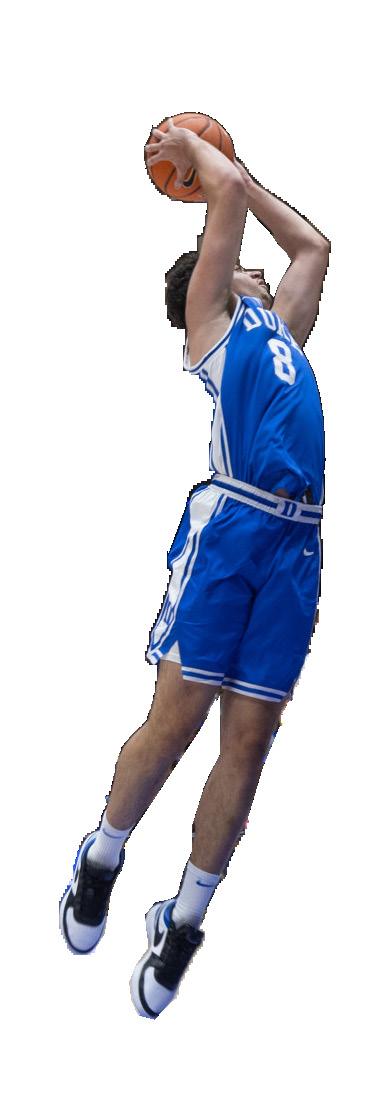
“I chose Duke because it felt like home,” Ngongba told ESPN when he committed. “I like its plan for me, and I trust the coaches. It is a place where we can win and help me get to the next level.”
Harris and Ngongba hope to assist Duke to another deep tournament run, just like their two fellow PVI alumni did in 2022. As Farello develops his program to a consistent national powerhouse, there’s no reason why this



By Ranjan Jindal Sports Editor
LeBron James barely stopped the unthinkable from happening.
With 10 seconds left, South Sudan led the United States by one point in an exhibition before the 2024 Paris Olympic Games. The 49-point underdogs, a team of mostly refugee players, fought their way to the end with the best in the world, but a James layup sealed the deal for the Americans.
That tough group — including 18-year-old Duke freshman Khaman Maluach — admirably represented their home country, which has gone through intense civil war and famine in its short 13-year history. South Sudan is younger than Maluach and is the newest country in the world. However, its basketball scene has exploded due to significant investment from former Blue Devil Luol Deng, the President of the South Sudan Basketball Federation.
Maluach was the youngest player on that roster. But how did someone who picked up a basketball for the first time in 2019 play on his country’s Olympic team?
“Once you walk into the academy, our system is for you to succeed. It’s not just basketball. Success looks different for everyone and it’s a 360 holistic approach towards success,” said Roland Houston, technical director of NBA Academy Africa, in an interview with The Chronicle. “We’re very fortunate and we put a team in place to arm these young people with information so when they leave us, they’re prepared to succeed in whatever venture that they have in front of them.”
Maluach clearly was a blossoming product. A 7-foot-2 center with a natural rim protection ability and a functional 3-point jump shot already makes college coaches salivate. But it was Maluach’s mentality that impressed Houston the most, which he believes will serve the freshman well at Duke.
Once you walk into the academy, our system is for you to succeed. It’s not just basketball.
“A kid like [Khaman] is a no-brainer,” Houston said. “He approaches things in a methodical way where he knows he wants to succeed. He doesn’t want to be around anything that’s not conducive for his success, and he’s laser focused on succeeding.”
A typical day at the NBA Academy is intended to model college life.
Roland Houston Technical director of NBA Africa
When he was 14 years old, Maluach was scouted and accepted into the NBA Academy Africa in Senegal, the youngest ever player to join an NBA academy. This program is part of a larger network by the NBA to assist talented players globally to reach their aspirations while playing in their home continents.
In 2017, the NBA launched academies in Africa, India and Australia; Mexico received one the following year. These new institutions provide an alternative to prep schools in Europe and the United States — previously, the most common routes for top talent from the Global South. The NBA Global Academy directly removes barriers for its participants to reach their full potential, whether that be in college basketball, the G-league or even the NBA.
While NBA Academies focus on yearround basketball training, they provide dormitories and education services with world-class teachers, performance staff and professional-level coaches. Their schedules, however, are different from those at U.S. prep schools, as academy members play exhibitions against professional teams and other NBA Academy schools.
For Maluach, that started with a 6 a.m. gym session.
He had class for most of the day and came back for afternoon practice, and repeated that every day. The Academy provided him tutoring services when necessary — its emphasis on academic achievement is evident.
The nascent initiative has proven successful, with prospects from the academies graduating to professional leagues, college basketball and the NBA. Top alums include Josh Giddey, Bennedict Mathurin, Santiago Vescovi and Ulrich Chomche — the first graduate from NBA Academy Africa to get drafted directly into the NBA. Houston, who has multiple decades of college basketball coaching experience at George Mason, George Washington and La Salle, serves as a prime example of the kind of proven leader the NBA looks to employ.
“You just don’t have to take kids from Africa and put them in the [US] to grow,” Houston said. “That was one of the key elements that we’re extremely proud of, that a kid can come from [Africa] and go to a prestigious university such as Duke, or get drafted straight from the continent.”
Maluach isn’t the only NBA Academy product on this Blue Devil roster. Junior guard and Australia native Tyrese Proctor
joined the NBA Global Academy in Sydney at 15, and he described that training as consequential in his development.
“It’s produced multiple NBA players, so I think that sort of speaks for itself,” Proctor said at ACC Media Day in October. “But NBA Academy changed my life and helped me out so much. Leaving home at 15 was a big sacrifice and risk, but they welcomed me with open arms and I loved every moment of it.”
As a result, the two knew each other through the academy network, and Proctor has been influential on “his brother’s” transition into Duke and America. Prior to preparing for the 2024 Paris Games, Maluach came to Durham and lived with Proctor.
“Tyrese has been helping me a lot because we both have the same background as we’re from overseas,” Maluach said. “Tyrese is teaching me how to handle everything and I spend a lot of time with him.”
Even though the academies are a closer alternative to schools in the United States, it’s a big sacrifice for 14- and 15-year-old kids to move away from everything they know. For Maluach, who lived in Uganda after his parents fled South Sudan, Senegal was more than 3,000 miles away. It was his first ever trip on a plane. It’s essential for Houston to form a bond between his players through basketball, because they come from different cultures and languages.
“We try to build a sense of community and environment that’s conducive for growth, and it’s like a brotherhood,” Houston said. “[Building culture] took a period of time. It took leadership from certain guys and when they understood that we were trying to build something special, they embraced it.”
With only a few spots in each academy — Maluach was 1 of 21 in NBA Africa — each admission is carefully adjudicated.
The NBA Academies use the Jr. NBA, a network of leagues for kids 6-14 across the world, to scout talent. These programs get kids of all levels started with fundamental work and organized basketball practice. There are seven Jr. NBA/WNBA leagues across Africa, including one in South Sudan established in 2023 through a partnership with the Luol Deng foundation.
“The Jr. NBA is a huge part of development globally. We have a network of scouts or relationships of coaches that we utilize in order to identify players,” Houston said. “For example, you have a coach in the Congo, Nigeria or Senegal with relationships, they will say, ‘Coach, here is a kid. He’s pretty good, he’s special. He just needs an opportunity.’”
That sentiment rings true, because these NBA Academies decrease the gap in basketball infrastructure across the world with the simple promise of a chance. With a multitude of untapped potential, the game can reach new heights and populations. This was the case with Maluach, who was spotted by an NBA Academy Africa scout which changed his life.
“Obviously you can see with what happened in South Sudan, a lot of the kids on the continent — they just need opportunities,” Houston said. “I think with the more opportunities that they have, the more growth that you will see on the continent.”
Another key reason that the NBA Academies have such a gap to fill: Soccer. Outside of the U.S., kids play soccer before anything else (Proctor, for his part, still dominates his Blue Devil teammates in FIFA). As a result, Houston explained that while Americans tend to start playing basketball in the first decade of their lives, it’s common for Africans to start between the ages of 12 and 14, like Maluach did. The quality of coaches the NBA Academy provides, then, is even more essential; they have to accelerate the learning process.
“Most of these kids grow up with their feet, where we grow up with our hands,” Houston said.
The talent is there, so the future of basketball is clearly a more globalized game. As South Sudan’s Wenyen Gabriel emotionally noted following his country’s Olympic performance, he witnessed 7-footers herding cows in South Sudan because of the resource gap and lack of opportunities for basketball development.
“The kids that we touch, our focus is for them to be the best athlete, basketball player and human being that they could possibly be while taking advantage of what the NBA has provided,” Houston said.
Maluach grew up not knowing anything about basketball, but was inspired by highlight reels of Zion Williamson. This is how he explains the gravity of his accomplishments back home, telling his cousins he plays “at Zion Williamson’s school.”
Draped with his hometown flag on his back, Maluach is an inspiration for 12 million — and more — an ocean away. He proved that a country without an indoor basketball court can produce a player at one of the United States’ biggest basketball programs.
The NBA Academy gave 14-year-old Maluach a shot at making his dreams a reality. And 15-year-old Proctor’s. And hundreds of deserving players across the world.
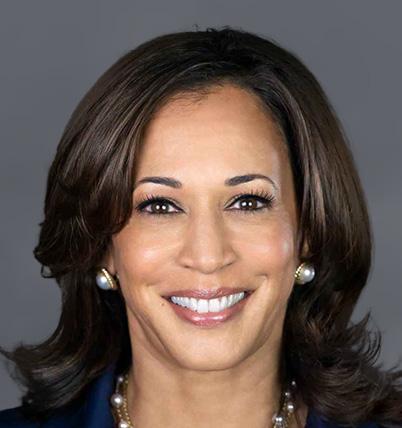
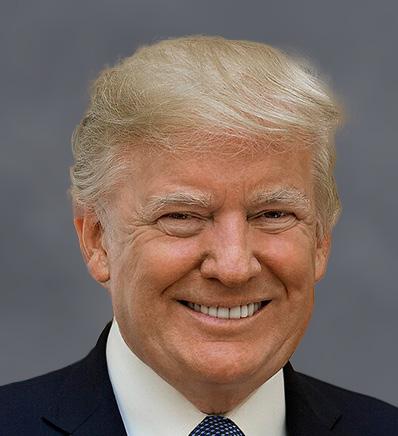
See guides.vote for online guides with links & source
ABORTION
Ban or legal?
CLIMATE CHANGE
Should climate change be a top priority?
CRIMINAL JUSTICE
How to ensure effectiveness and fairness in law enforcement?
How to improve the economy and make daily life more affordable.
kamalaharris.com
Legal. “Every woman should have the right to make decisions about her own body.” “This fight is about freedom.” With Biden, strengthened abortion pill access and abortion patient protections, overturned Trump Planned Parenthood federal funding ban. Would sign national abortion rights bill if Congress passed.
Yes. We’re seeing the climate crisis “every day…in real time.“ “We must do more.” Cast the deciding vote to commit $369 billion to climate and clean energy, the biggest investment in US history. Supported $1.2 trillion in infrastructure; includes reducing greenhouse gas emissions. No longer would ban hydraulic fracking.
Police are dedicated public servants. As a prosecutor increased felony convictions by one third. But “public safety requires community trust.” Has supported better training, banning choke holds, and prosecuting police misconduct.
Expand child tax credit. Give tax credits for affordable housing builders and subsidize first-time home buyers. Restrict price gouging on groceries and lower drug costs by negotiating prices. Supported bipartisan infrastructure bill.
Limit teaching about racism and gender identity? No. In Florida “extremists… passed a law, ‘Don’t Say Gay,’ trying to instill fear in our teachers.” Now, “they want to replace history with lies,” teaching “that enslaved people benefited from slavery.” Children should be “taught the truth.”
Did Joe Biden win the 2020 Presidential election?
Loosen or tighten gun regulations?
HEALTHCARE
Repeal or expand the Affordable Care Act (ACA), also known as Obamacare?
Yes. “The [election] results were certified by state after state and reaffirmed by court after court.” “On January 6, we all saw what our nation would look like if the forces who seek to dismantle our democracy are successful.”
Tighten. “Every person deserves the freedom to live safe from gun violence.” Supported the bipartisan gun safety bill and required background checks for gun show & online sales.
Expand. “Health care is a right, not a privilege.” Cast a tie-breaking Senate vote to expand ACA & lower Medicare drug prices, including a $35 monthly insulin cost. Would link drug costs to costs that comparable wealthy nations pay.
donaldjtrump.com
Ban. “After 50 years of failure, I was able to kill Roe v. Wade.” Did so by appointing three anti-abortion Supreme Court Justices. It was “a miracle.” States should decide for themselves, potentially monitoring women’s pregnancies and prosecuting women for getting abortions. Abortion is “really not that big of an issue.”
No. Climate change is a “hoax.” The world will “start getting cooler.” Withdrew from the Paris climate pact. Will expand coal and oil production. “I want to drill, baby, drill.” Asked oil and gas executives to donate $1 billion so he could reverse Biden’s climate initiatives.
Police are “under siege.” Cut back active federal oversight of excess force, though supported a database to track it. Admires Chinese approach of quick trials and a death penalty for drug dealers so there will be a “zero drug problem.”
Increase taxes (tariffs) on imported goods. Cut housing demand with mass deportations. To lower prices, would deregulate businesses, rein in “wasteful federal spending” and unleash American energy. Opposed infrastructure bill.
Yes. Certify teachers who “embrace patriotic values.” Would “cut federal funding” for any school “pushing critical race theory, gender ideology.” Restricted diversity training for federal employees and contractors.
No. Called the election a “Big Lie” and a “Massive Fraud” that would justify “termination” of parts of Constitution. Called those who stormed U.S. Capitol “unbelievable patriots.” Would pardon them fully.
Loosen. To NRA, “no one will lay a finger on your firearms.” Plans to roll back Biden gun restrictions. Reversed Obama-era background checks for those with mental illnesses.
Repeal. “Terminate.” “Obamacare is a catastrophe.” As President, promised to replace it with “something terrific,” but repeal failed in the Senate by one vote. Supported an unsuccessful lawsuit to overturn it.
IMMIGRATION
How to handle immigration?
Support a path to citizenship for “DACA” participants brought to the US as children?
ISRAEL/GAZA
Response to Israel’s invasion of Gaza following October Hamas attack?
LABOR
Make it easier or harder for unions to organize?
LGBTQ RIGHTS
Limit or expand LGBTQ rights?
MARIJUANA
Ban or legal?
MINIMUM WAGE
Raise federal minimum from $7.25 an hour?
SOCIAL SECURITY
Cut Social Security or raise retirement age to stabilize program?
STUDENT FINANCIAL AID
Support lowering interest on student loans and/or forgiving them?
TAXES
Raise or lower taxes on the wealthy and corporations?
UKRAINE/RUSSIA
Support defending Ukraine against Russian invasion?
VOTING RULES
Make voting harder or easier?
Supports “comprehensive immigration reform.” Backed the bipartisan Senate border security bill. Rejects mass deportation of undocumented immigrants. “We are a nation of immigrants…. let us all address [the issue] with the urgency and seriousness it requires.” Supports pathways to citizenship for DACA participants and undocumented spouses of citizens.
“We need” a cease-fire & a two-state solution. “Israel has a right to defend itself.” But “too many innocent Palestinians have been killed… Civilian suffering… [is] devastating.” Palestinians and Israelis both “are entitled to security.”
Easier. “Unions built” the American middle class. “We are fighting to protect the sacred right to organize.” Backs pro-union laws. Walked UAW picket line. Build “an economy where every person, not just the wealthy,” can thrive.
Expand. In 2004, officiated some of the nation’s first same-sex marriages. Helped repeal California’s antigay marriage initiative. Biden administration protected LGBTQ medical patients from discrimination.
Legal. “Nobody should have to go to jail for smoking weed.” Legalize and regulate. Supports Biden’s easing federal prohibition.
Yes. Supports Congress raising the national minimum wage to $15. Biden administration raised to $15 for federal contractors.
No. Would protect and stabilize Social Security by making wealthier Americans pay into Social Security at the same rate as everyone else; they’d keep paying in above their current $168,600/year income cap.
Yes. Supported Biden forgiving $144 billion for over 4 million borrowers, after the Supreme Court blocked the Biden-Harris $430 billion forgiveness plan.
Raise. Voted against Trump tax cuts, which included the largest corporate cut in US history. Supported increasing corporate tax rates. To boost teacher salaries, proposed raising estate taxes on the very wealthy.
Yes. “Regarding Putin’s unprovoked, unjustified war against Ukraine… we are committed to… defend democratic values and stand up to dictators.”
Easier. Pass bills to protect voting rights and make voting and registration easier. Biden administration directed federal agencies to help people register.
Illegal immigrants are “poisoning the blood of our country.” Will use the National Guard and local police, with possible detention camps, to deport 15 to 20 million illegal immigrants. Opposed the bipartisan Senate immigration bill. Tried to end DACA; Supreme Court overruled. Would renew his Muslim ban and end automatic citizenship for everyone born in US
Has supported Israeli action, “get the job done.” Says Israel releasing images of bombed Gaza buildings loses “the PR war.” Gaza protesters are “raging lunatics and Hamas sympathizers.” Would deport student protesters.
Harder. Made it harder for unions to organize. Restricted federal employee collective bargaining. Praised employers who fire striking workers: “They go on strike…and you say… ‘You’re all gone.’” Striking Auto Workers were “sold down the river by their leadership.”
Limit. Weakened an Obama order protecting LGBTQ federal contractors from discrimination. Banned transgender military servicemembers and ended antidiscrimination protections for transgender patients.
Unclear. It does “significant damage.” Reversed Obama rule to not prosecute in states where legal, but ultimately didn’t prosecute.
No. A $15 minimum wage would “eliminate jobs.” Threatened to veto. Questioned need for a federal minimum wage: let the states decide.
Mostly yes. There’s “a lot you can do in… cutting.” Also flags bad management. Proposed $35 billion cuts in Social Security disability programs. But “will never do anything” to “hurt Social Security.”
No. Called student loan forgiveness “unfair” to those not attending college. Vetoed forgiving loans of defrauded students. Proposed cutting support programs for student borrowers.
Lower. His 2017 tax cut included the largest corporate cuts in US history and major tax cuts for the wealthy. Would extend and expand when they expire in 2025. Raising business taxes “will lead to the destruction of your jobs.”
Mostly no. To end the war, will push Ukraine to give up territory to Russia. Russia should “do whatever the hell they want” to NATO countries that don’t pay enough.
Harder. Has long supported stronger voter ID requirements. Sued to bar ballot drop boxes. Encouraged Republicans to vote early but said early ballots “get lost” or are “phony.”
guides.vote is a nonpartisan effort to show where candidates stand. We do not support or oppose any political party or candidate. We include candidates polling 15% or more; use the QR code on the right for online versions, including links to credible sources and other candidates. Vote411.org offers guides to local races and how to vote. For campuses, see Campus Vote Project’s state-specific guides to student voting rules.

‘I was in the Denny’s’: John Feinstein’s one-of-a-
By Dom Fenoglio Sports Managing Editor
Duke fans talk about Mike Krzyzewski as if he were a god. The church of Cameron Indoor bears his name, as does the hallowed lawn where students camp for weeks to have the chance to worship the program he built.
Listening to Krzyzewski talk with John Feinstein, though, it’s easy to forget the reverie.
Feinstein, who spent hours interviewing Krzyzewski and former players for his new book “Five Banners: Inside the Duke Basketball Dynasty,” traded jokes back and forth with the coach like old friends — which, of course, they are.
“Mike Krzyzewski curses sometimes, usually at me,” Feinstein said.
“Only when you deserve it,” came the retort from Krzyzewski.
The author and lifelong sports journalist met Krzyzewski back when he coached at Army, and the two remained extremely close throughout Krzyzewski’s 42 years with the Blue Devils. Feinstein was there to embrace Krzyzewski when Duke won its first national
championship in 1991, and he was there in 1983 at the lowest point in Krzyzewski’s career.
A Duke graduate himself, Feinstein was one of the few media members not initially and perpetually against Krzyzewski. Instead of criticizing Krzyzewski or taking the side of the local favorites North Carolina and N.C. State, Feinstein fostered a relationship with the Duke coach that allowed him to see stories that no one else could. While he usually writes neutrally on the Blue Devils, “Five Banners” allowed Feinstein to fully embrace his roots and tell the story of one of the most impressive sports dynasties of all time.
on the runway at the Raleigh-Durham airport, Krzyzewski’s ascent to greatness was not a smooth takeoff.
A 17-13 debut season in 1980-81 was followed by two consecutive losing records — something that has not since happened at Duke. The night the Blue Devils were bounced from the 1983 ACC tournament, Feinstein was at a Denny’s with Krzyzewski and a few other close friends. In his book, Feinstein describes Krzyzewski’s raw anger in the moment and how the coach never wanted to forget how it felt to lose.
As Krzyzewski and the Blue Devils climbed to new heights, Feinstein was there to chronicle their journey. He also had a frontrow seat to the media’s reactions to Duke’s successes. While they at first welcomed the emergence of the Blue Devils to the national stage, it did not take long for jealousies to creep in.
Grant says, ‘If I don’t get the pass there, it doesn’t matter.’
And Christian says, ‘The pass was easy, the shot was the challenge.’
“I can write something that doesn’t mention Duke at all, and people say, ‘well, it’s just from a Dukie,’” Feinstein told The Chronicle. “[Here] I was allowed to be a Duke graduate. And I enjoyed saying, ‘look, this book’s being published by Duke University Press. I went to Duke. This is about five Duke championships that I covered and it was just fun. It was great fun.’”
JOHN FEINSTEIN Sports journalist

The beginning of Krzyzewski’s career with the Blue Devils can at best be described as tumultuous. After getting hired by then-athletic director Tom Butters
But Butters had faith in Krzyzewski. Even amidst calls to fire the new coach, the athletic director remained steadfast in his support of the young play caller.
“The four most powerful words in the English language are ‘I believe in you,’” Krzyzewski said during an event promoting Feinstein’s book. “And Tom Butters — I get chills thinking about it — because I wouldn’t be here today if Tom Butters didn’t say that to me.”
Just three years later in 1986, Krzyzewski rewarded Butters’ belief in him by reaching his first Final Four. While that team fell to Louisville in the championship game, it set the tone for what was to come for Krzyzewski. Duke reached the Final Four in six of the seven years from 1986 to 1992, with the final two seasons culminating into back-to-back national championships.
“I was at the press conference on Sunday in ‘86, Mike’s first Final Four, and the kids [were] hitting it out of the park up on the podium,” Feinstein said. “That almost started [the hate against Duke], that whole press conference. And then coming back and beating Vegas in ‘91 when they weren’t supposed to, and then repeating the next year thanks to Christian [Laettner’s] shot and Grant [Hill’s] pass.”
The play Feinstein is referring to is the most famous in Duke history. In the 1992 Elite Eight against Kentucky, the Blue Devils trailed by one in overtime. Krzyzewski drew up a play in which Hill would throw a full-court pass to Laettner, and the coach famously asked Laettner in the huddle if he could make the game-winning shot. Laettner didn’t bother answering, and instead gave his response moments later by sending Duke to the Final Four.
“It was funny to hear Christian’s teammates talk about the fact that he was an asshole, and that’s his nickname, but they sure as hell like having him on their team for obvious reasons,”




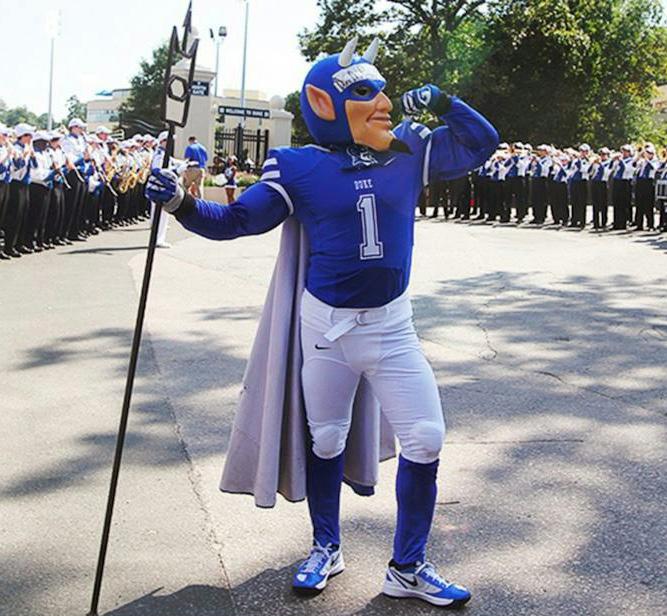


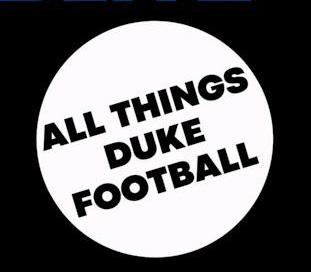


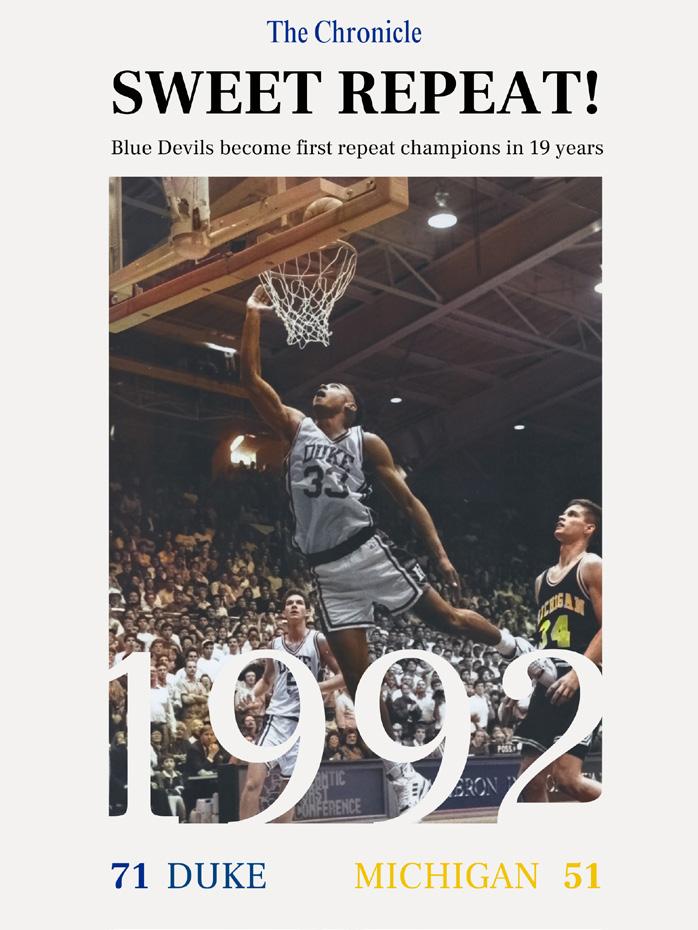
Feinstein said about the interviews he conducted in writing his book. “Christian and Grant [argued] about whose role was more important in the shot. Grant says, ‘If I don’t get the pass there, it doesn’t matter.’ And Christian says, ‘The pass was easy, the shot was the challenge.’”
After Laettner and Hill graduated, the Blue Devils remained near the top of college basketball, but great team after great team came up short. Coupled with a personal illness that kept Krzyzewski out for much of the 1994-95 season, fans were beginning to wonder if Duke would ever reach the mountaintop again.
Then came the 2000-01 team, which had six future NBA players. The Blue Devils opened the season near the top of the AP poll and looked invincible, but adversity hit when star big man Carlos Boozer suffered a broken right foot in a loss to Maryland.
Krzyzewski — who had been working with essentially a six-man rotation — had little time to adapt, as next on the schedule was a matchup with the archrival Tar Heels. Krzyzewski stayed up all night breaking down his options and ended up deciding on a strategy a decade ahead of his time.
In his book, Feinstein describes how Krzyzewski broke down the game plan to his team: shoot threes, and shoot often. The replacements down low for Boozer would not try to recreate his interior presence; instead, their job was to feed the perimeter shooters.
“If you think about it, what Coach K did was apply analytics to the situation when no one — including him — really knew what analytics were,” Shane Battier said in “Five Banners.” “Overnight, literally overnight, he came up with an offense that, statistically speaking, needed to shoot as many threes as possible.”
The strategy paid off, as Duke took down North Carolina 95-81, and Boozer eventually returned to help lead the Blue Devils to their third national title. By this point, Krzyzewski was already in rare air, and the NBA was calling. A few years after his third title, Krzyzewski was offered a job with the Lakers.
He turned it down, prompting a speech from then-university president Richard Brodhead in which he praised Krzyzewski for staying and even compared him to Mother Teresa, Winston Churchill and John F. Kennedy. Still, by the time the 2009-10 season rolled around, fans were once again anxious for another banner.
Early on in that season, Krzyzewski was poised to overtake North Carolina’s Hall of Fame coach Dean Smith in career wins. Feinstein decided to spend the entire day with Krzyzewski to write about the moment, including a ride on the team bus — something no one, not even Krzyzewski’s closest advisors, got to do. In a retelling of a conversation with Mike Cragg, a longtime member of Duke’s athletic department, Feinstein explained why he got such intimate access.
Cragg told him, “No, no, you misunderstood something. Nobody except Mickie [Krzyzewski] rides that bus who is not part of the team. I don’t even ride that bus.”
Feinstein described how Cragg shook his head in disbelief. “Why? Why would [Krzyzewski] let you ride on the bus?”
“And I said,” Feinstein recalled, “‘because I was in the Denny’s.’”
Led by Jon Scheyer, those 2009-10 Blue Devils fought their way to a national championship game appearance against Butler. Playing in Indianapolis as heavy favorites
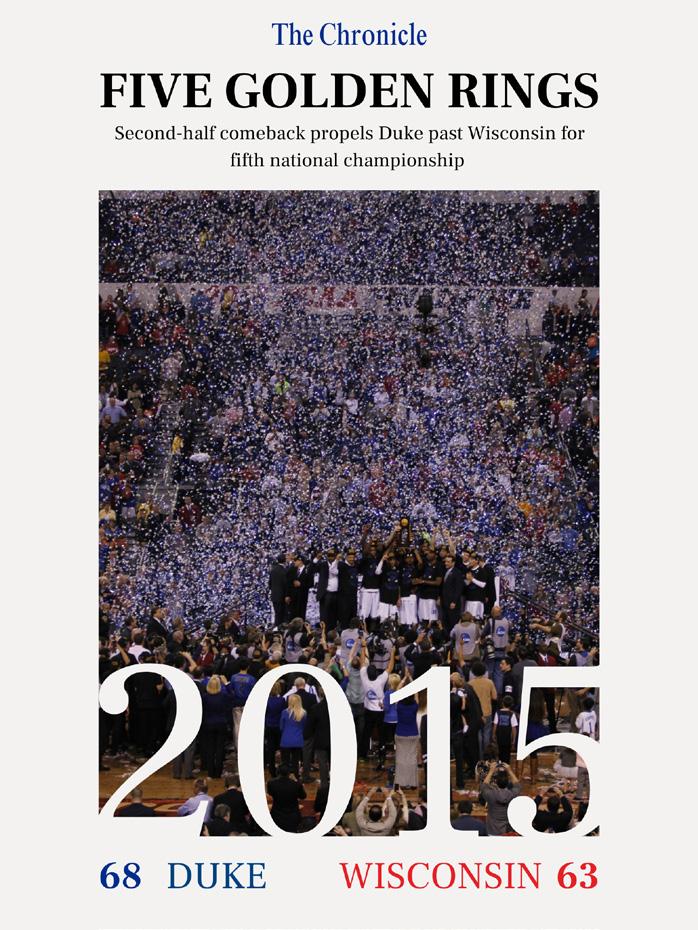
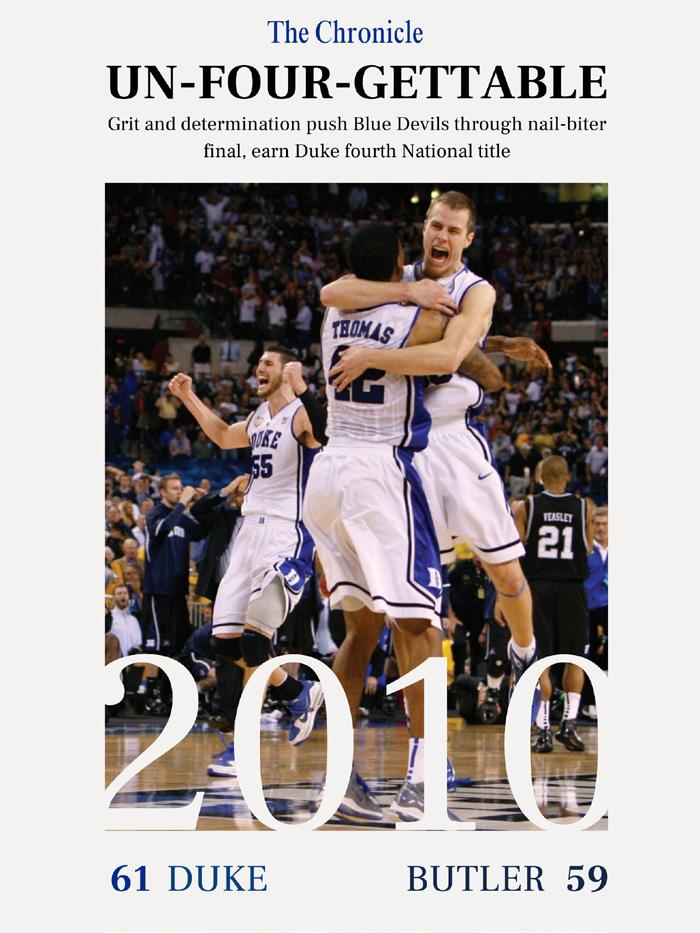
against the hometown kids, Feinstein compared the game to the classic basketball movie “Hoosiers” — Butler even had its own Jimmy Chitwood in star forward Gordon Hayward. The game nearly had a Hollywood ending for the Bulldogs, but a halfcourt heave from Hayward rimmed out and instead it was the Blue Devils celebrating.
After that championship run, Krzyzewski completely changed some of his core philosophies in his final years with the program. First it was recruiting one-and-done players, something Krzyzewski had long admonished because it limited the time he could develop a team. Then, in 2015 — the year of Krzyzewski’s final banner — he changed the very thing that brought him to Durham.
great is his ability to adapt to the needs of the moment and create a new way forward.
The stories Feinstein shares in his book do more than retell the history of Duke basketball. Through his unparalleled access to one of the most impressive leaders of all time in Krzyzewski, Feinstein gives a blueprint into what leadership looks like and how greatness is made.
You don’t put banners up by beating another school, you put banners up by beating everybody.
Mike Krzyzewski Former Duke head coach
Feinstein noted that when Butters was looking for a coach way back in 1980, it was defense that drew him to Krzyzewski. Steve Vacendak, an associate athletic director at the time, recommended the then-Army coach because he was “hell on wheels on the defensive end.”
Specifically, Krzyzewski coached an aggressive man-to-man system for nearly all of his career. However, with his team struggling midway through the 2015 season, he turned to a zone defense to change the tide. Of course, Krzyzewski’s decision paid off, as the team’s confidence grew to help it eventually cut down the nets after beating Wisconsin.
Feinstein emphasizes repeatedly in his book that what separates Krzyzewski as an all-time
“You don’t put banners up by beating another school, you put banners up by beating everybody,” Krzyzewski said. “When I was a cadet at West Point, the freshmen would salute the upperclassmen. And they would say, ‘beat Navy, sir.’ So I got all my plebes together. I said, ‘Don’t ever say that to me.’ This is when I was a senior in West Point. ‘When you see me, say beat everybody.’”
It’s that mentality which cements the legend of Coach K in Duke history. But for Feinstein, Krzyzewski is still just an old friend.
The writer said to Krzyzewski, “Look, we give each other a hard time a lot. I just want you to know how much I appreciate you giving me all this time.”
Duke’s legendary basketball coach turned to his friend, and said, “No, no, John, I should be thanking you.”
“Why?”
“I’m Catholic,” Krzyzewski said. “When I die, I can tell God I’ve already been through purgatory.’”
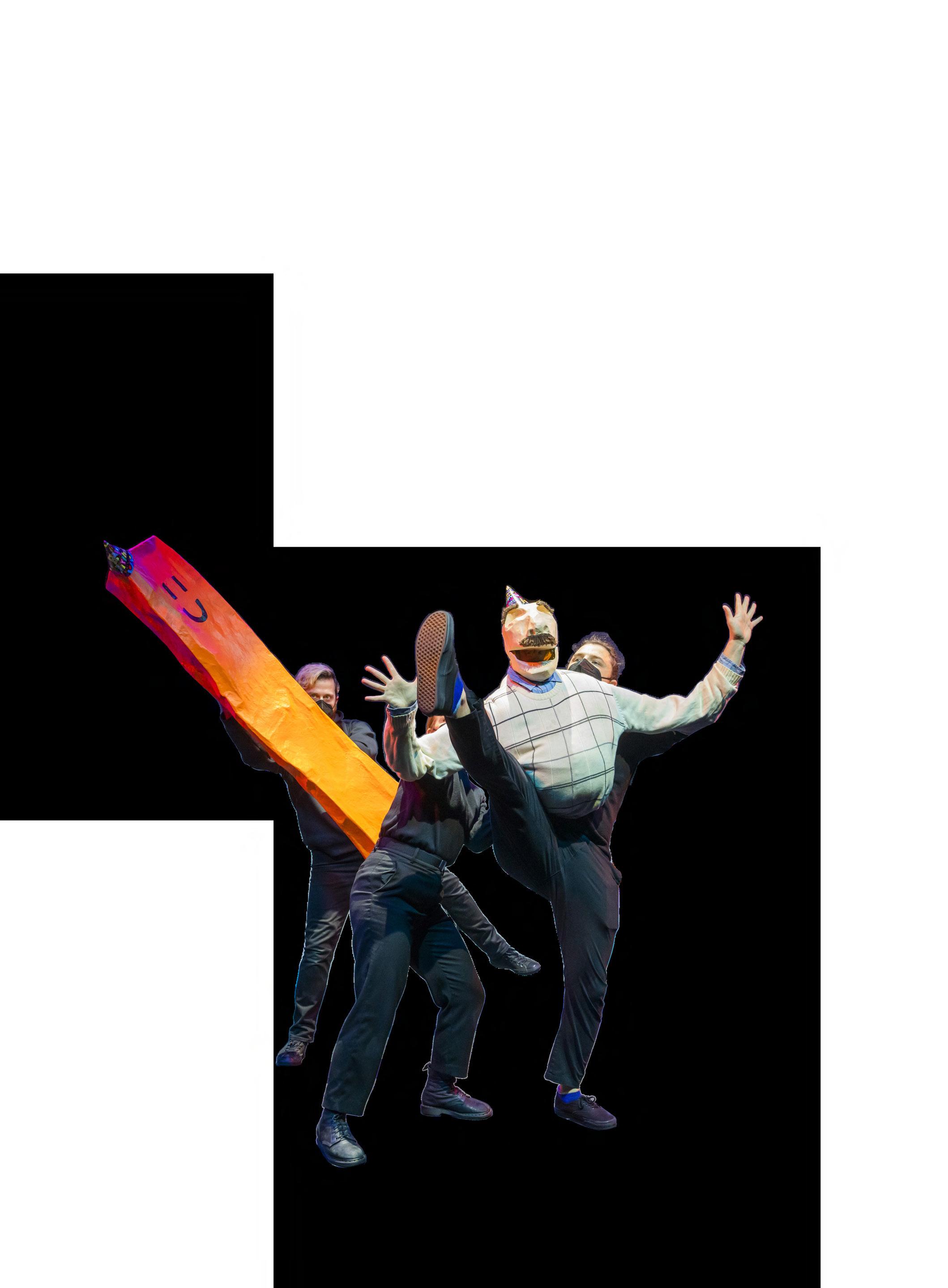


By Abby DiSalvo Assistant Blue Zone Editor
This season, the ball is in Caleb Foster’s court.
Duke’s then-freshman guard watched from the bench last year as the Blue Devils ceded the regular-season ACC title in a devastating loss to North Carolina. He held his breath along with thousands of fans as Tyrese Proctor got a crucial stop against Houston to advance through the Sweet Sixteen. And when Duke fell to N.C. State in the Elite Eight, he sat helplessly in the reserves, still sidelined with the right ankle stress fracture that would keep him off the court until June.
Now, Foster has returned to the floor with the help of a podcast, a pool and a fresh perspective.
The otherwise quiet player from Harrisburg, N.C., has stepped up as shepherd of the nation’s top recruiting class. Duke’s talented roster boasts six freshmen and four transfers, but Foster is one of only two returners with meaningful experience in Cameron Indoor Stadium. His 689 minutes in a Blue Devil uniform slotted him into a veteran role right alongside junior guard Proctor, his roommate and backcourt buddy.
It’s an atypical position for a sophomore, but Duke is not your typical basketball school. After living The Brotherhood’s principles for a year, Foster embraced the task of passing them on to the newest Blue Devils. He also worked through an ambitious injury recovery
plan designed to help him stand out on a starstudded team.
Developing a vocal presence was Foster’s first step towards a leadership role. He took a seat behind the microphone of The Brotherhood Podcast — hosted last year by then-captain Ryan Young — to conduct interviews with current and former Duke players, along with staff members. Talking to teammates and guests each Tuesday quickly helped Foster develop a more confident voice. After hosting 19 episodes, he’s even refined a familiar opening line: “What’s up, Brotherhood Podcast? It’s your boy C-Fos, bringing you another special episode.”
“I’m really not — I wasn’t — the guy to talk a lot. But now, stepping into the leadership role, that’s something that comes with it,”
Foster said at ACC media days. “[Hosting the podcast was] definitely stepping out of my comfort zone. At first, I was like, ‘I don’t know if I want to do it,’ but then I stepped in and I got comfortable doing it and I love it.”
The podcast has also helped Foster form connections with his teammates. Each interview reveals unique details from their jersey number picks to why they chose Duke. We now know that Khaman Maluach loves playing FIFA, Kon Knueppel’s favorite vacation spot is Sturgeon Bay, Wis., and Cooper Flagg prefers Chick-fil-A as his pregame meal. It’s all fun and games in the studio, but that relationship translates to trust and confidence on the court.
Foster has helped the young Blue Devils find their footing, one step at a time. He’s
the old guard ushering in a new era of Duke basketball.
“I’ve been through this,” Foster said. “I know the expectations. I know what it’s like to win the game, I know what it’s like to lose the game. I know how the fans react, and I know how the outside noise is. So I just try to help the young guys be prepared.”
Meanwhile, the 6-foot-5 guard has undergone intense preparation of his own, rehabbing from surgery that repaired his fractured ankle with a plate and screws. After spending half of last season unable to run without pain, Foster wanted to return to the court untouchable.
“The big thing for me coming off injury was to get in the best shape of my life,” he said. “So I
can just go out there and run around and not get tired playing my best at a high level for 40 minutes.”
Foster supplemented the typical surgical rehab — stretching, strength training and mobility — with swim lessons at Duke’s lap pool. He even continued the extra training after receiving clearance to return to the court, citing physical and mental benefits.
“Swimming is both great conditioning and low impact on the body, so it’s great to knock both out and not spend any damage on my knees,” Foster said. “And I actually enjoy it. I’m
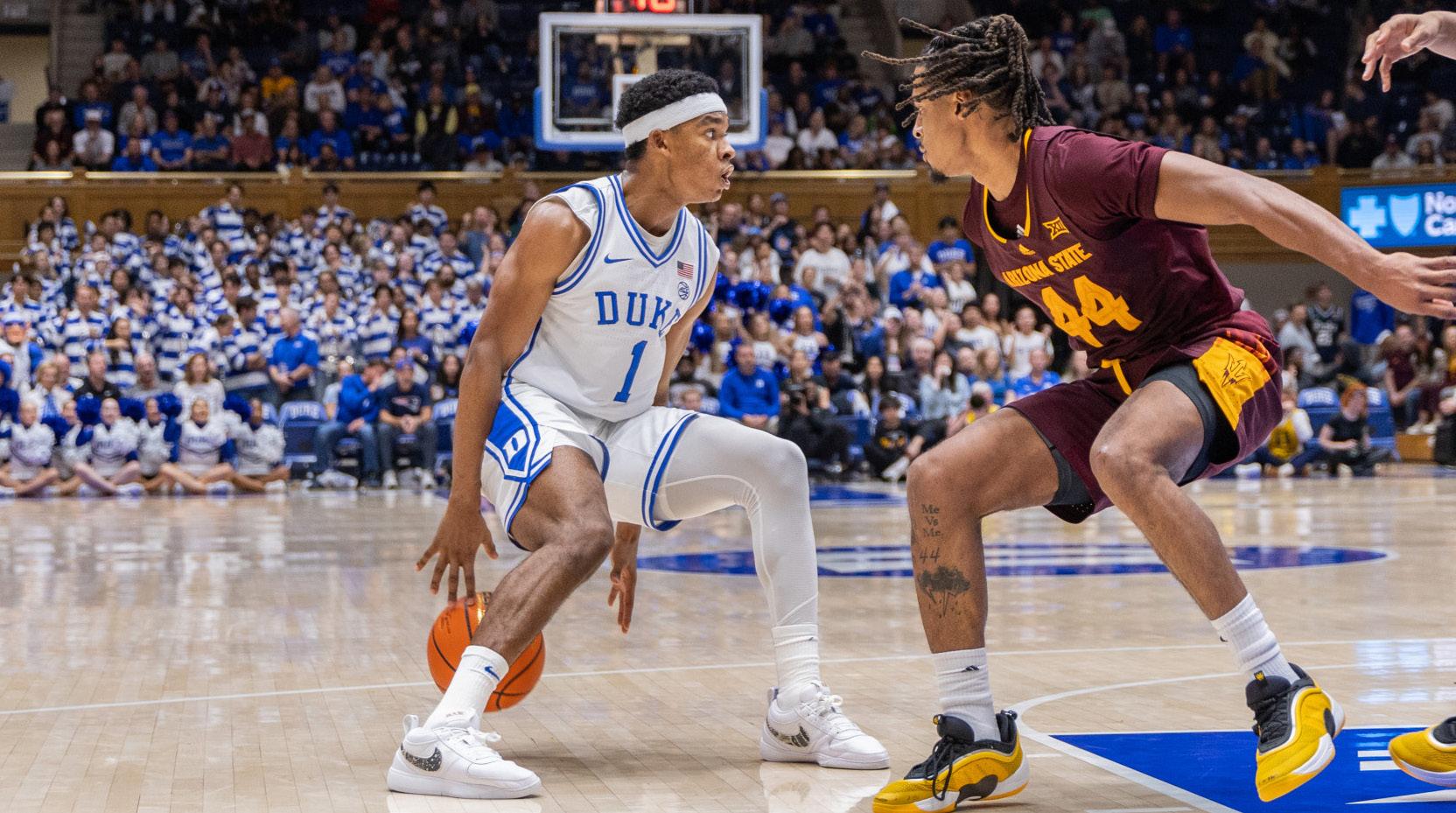






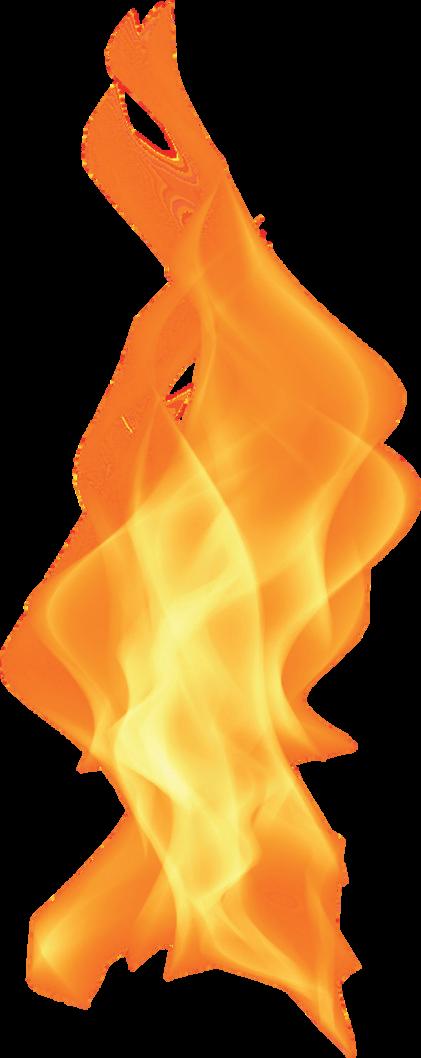








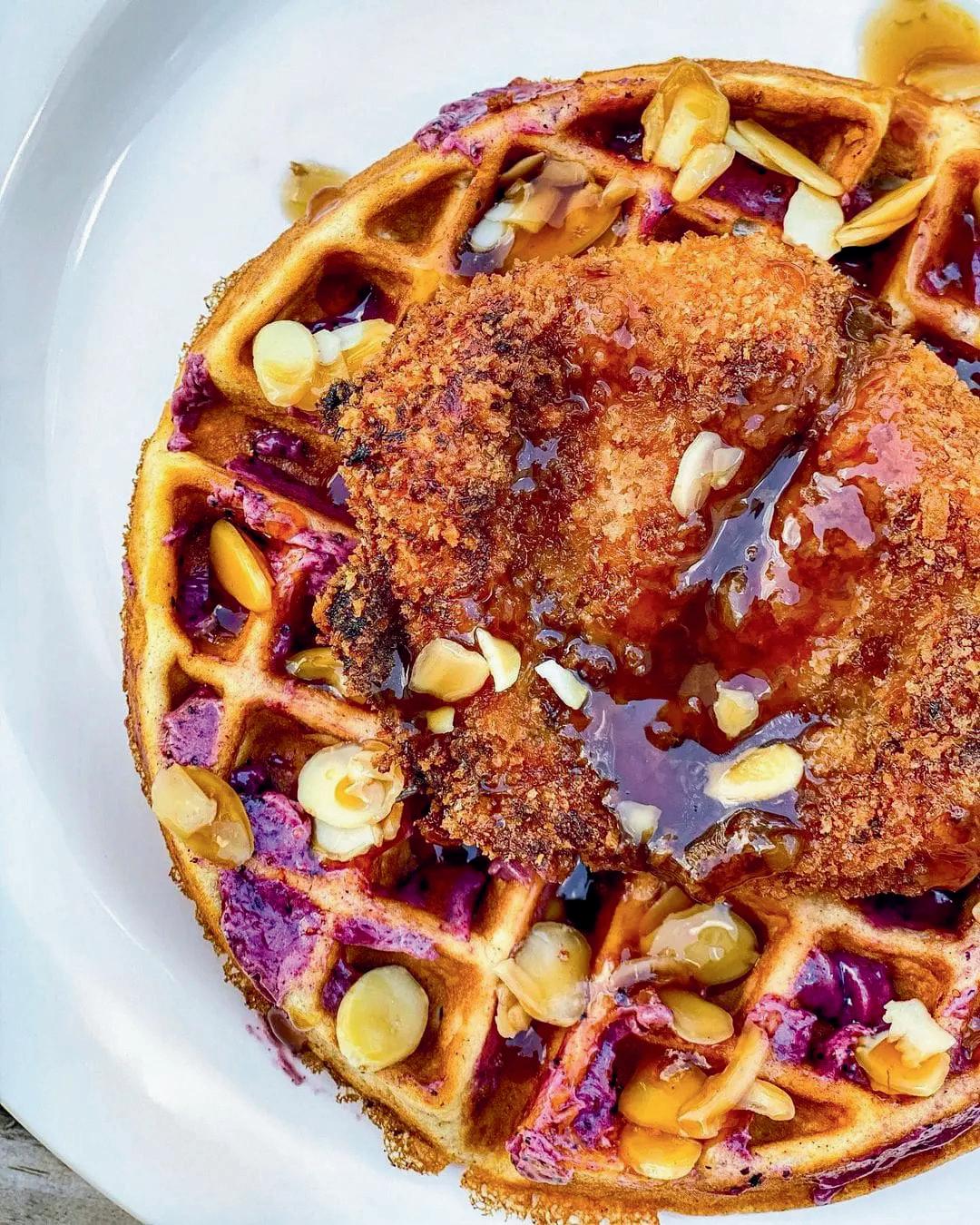

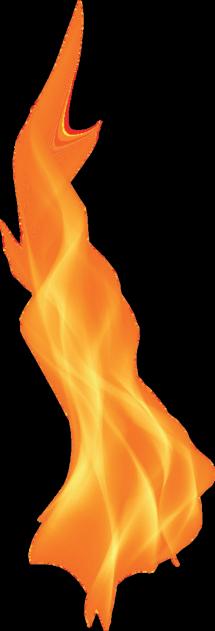

By Andrew Long Senior Editor
Forget February. Groundhog Day happens in the fall.
It often goes something like this: Hype the ceiling of a roster headlined by a generational first-rounder, a couple sophomore starters and a spinning door of four- and five-star freshmen with concerns that it may lack experience. Come March, Duke loses a close tournament game to a more veteran team, prompting fans to wish
have felt recently about Duke’s freshman-focused approach to roster construction. Despite a level of success most college basketball fan bases would sacrifice a limb for, there seems to be a lot of grumbling from title-starved fans about Duke’s perceived lack of experience and depth, and how it keeps costing the team in March.
I want to address those fans with some good news. Amidst some sameness, there’s a change in this year’s Groundhog Day programming. To complement yet another top-ranked recruiting class, Duke added valuable pieces in the portal — Mason Gillis from Purdue, Sion James from Tulane, Maliq Brown from Syracuse — who will all likely see substantial minutes.

That’s almost unheard of in Durham. And in this new age of college hoops, it’s a vital shift if Duke hopes to play basketball in April. If it works as well as I think it will, I also believe it will become a regular offseason ritual in the same way five-star, one-anddone recruiting has.
Duke has had portal pieces before (Ryan Young, Jacob Grandison, Theo John, to name a few) but they hardly fought for starting minutes or put up competitive scoring numbers. That’s different this year.
If there’s one thing we’ve learned about college basketball in the last few years, it’s that the portal is the most effective method to address roster deficiencies. With NIL deals now legal and fifth-, sixth- and seventh-year
seniors playing college ball, experience is more valuable and available than ever before.
As a result, it has become increasingly difficult for young rosters, no matter how talented, to deliver consistently. That’s not to speak of the depth the portal can add, since it allows teams to address needs after players like Jared McCain and Kyle Filipowski leave for the NBA and would-be depth pieces like TJ Power and Sean Stewart head elsewhere.
Before we get into why I think Scheyer’s use of the portal is so astute and so timely, we should understand how teams have used the portal so far. I’ve observed three categories of teams:
1.Use primarily the portal rather than elite recruiting to form a roster, focusing on experience and the hope that the group will click. Think 2023-24 N.C. State — although the team made a run to the Final Four, no starter was recruited by the Wolfpack.
2.Go all-in on recruiting with minimal portal use, secure top-five freshman classes each year, keep the players who aren’t one-and-done and use them as sophomores or juniors to lead new recruits. This has been Duke’s preference since the early 2010s. The Blue Devils haven’t had a recruiting class ranked outside the top six since winning the national title in 2015, but have only been to the Final Four once in that span and started at least one, often two or three, freshmen every year since, with few impact transfers.
3. Add a couple relevant portal pieces to fill gaps, all while staying hot on the recruiting trail. Examples are 2023-24 UConn and 2021-22
Kansas. Both teams’ preferred lineups featured a mix of veteran recruits like Donovan Clingan or Ochai Agbaji, a dynamic young starter and eventual NBA Draft pick like Stephon Castle or Jalen Wilson and game-breaking portal acquisitions like Tristen Newton, Cam Spencer or Remi Martin.
While the first approach can be successful, it’s overly reliant on favorable timing and how well the portal class fits a coach’s scheme. The second, as Duke has proven, is successful and replicable but often leaves rosters without vital experience and unforeseen holes.
The strength of the third approach — which is reflected in the past three national-title teams, might I add — is that it mixes the potential upside of the first strategy with the talent and cohesion of the second, all while ensuring schematic continuity and minimizing potential weaknesses. It feels like Scheyer has done the same thing this offseason, hence my bullishness.
The best part, in my opinion, is that he scouted for his team’s specific needs and who could solve them, while still prioritizing Duke’s strength in recruiting.
As Scheyer said himself: “Do you want to recruit Cooper Flagg going forward? Yeah, you want to recruit Cooper.”
Even with two elite returning guards and a stable of been-there-done-that transfer pieces, Scheyer’s freshman class is still one of his best


By Rachael Kaplan Senior Editor
Every Monday and Wednesday morning, 28 Duke students filter into a classroom on East Campus. Their professor, Dr. Javier Wallace, says hello to each one. He asks about their weekends, their semesters, their lives. Their upcoming trips and their job interviews. When the clock hits 10:05, they dive in with a discussion that centers around the lives of the six freshmen boys who sit together at one end of the room.
Men’s basketball academic coordinator Monty Montgomery was the guest of honor last week. But on this particular Monday, Duke Athletic Director Nina King is with the class for a Q&A. Wallace sits at the front with her, but she calls on students. They ask her about conference realignment, the unexpected consequences of NIL, athletes’ academic experience and the commodification of college athletes. She answers every question.
Experience,” he couldn’t stop thinking about the men’s basketball program.
A Google search on Duke men’s basketball history will teach you about its five national championships and its historic coaches. You will see its first game, a 1906 24-10 loss to Wake Forest, and the first Duke-North Carolina game in January 1920. It stretches to current head coach Jon Scheyer and the preseason All-Americansized expectations of current freshman Cooper Flagg.
How can we use Duke men’s basketball history and present to look at society, and specifically race in society and education?
Javier Wallace Race and sport postdoctoral associate
Wallace teaches a unique education elective called “Race, Sport & Education: Duke men’s basketball.” It’s the second time he’s running it.
“How can we use Duke men’s basketball history and present to look at society, and specifically race in society and education?” Wallace said of the course in an interview with The Chronicle. It serves to contextualize the racial history of the men’s basketball program and discuss common stereotypes in sports and at Duke.
The secrets of a storied program
Each summer, Duke offers numerous “plus” programs: paid research experiences in a specific subject. Story+ is focused on “arts & humanities research & storytelling.”
In 2022, Wallace, in his first months at Duke, led a Story+ team on the racial history of the Duke men’s basketball program. This was Wallace’s introduction to the Bull City and the history of Tobacco Road. While he was slated to teach a course that fall titled “Deporte Negrx: AfroLatinx Sport
Missing, however, are the connections — the nitty-gritty, sometimes ugly stories and facts that assisted the evolution of perhaps the most storied college basketball program in the country.
“What I gravitate to is to not shy away from these different conversations about race and what happened here for it to become Duke men’s basketball, with more than only white people playing here,” Wallace said. “Which is a difficult history.”
C.B. Claiborne, the first Black player for Duke men’s basketball, joined Wallace’s AfroLatinx Sport Experience course in fall 2022 and spoke to the students.
“I had this whole Black, Latin American syllabus,” Wallace said. “But then, because nobody in the class knew who C.B. Claiborne was, and because we had so many basketball players, I’m like, ‘You know what? Forget this. I want to invite him to come into our class.’”
Claiborne enrolled in 1965 — Duke was decades behind its counterparts.
Relaying an interview with former assistant coach Bucky Waters in 1965, a Chronicle columnist wrote, “The problem seems to be finding academically qualified Negro athletes who meet all the requirements of the Duke admissions office and who want to go to school in the South.”
Claiborne’s name, gaining recognition in the Duke community, is now celebrated as a sign of progress by the University. He received an honorary doctorate at the 2024 Commencement ceremony. What still goes largely unrecognized, however, is Claiborne’s
experience while at Duke, and why integration happened so late.
In Wallace’s class last year, Claiborne spoke candidly about his undergraduate experience. He was ordered to cut his hair by then-head coach Vic Bubas. He was a part of the Allen Building takeover. He was the target of abuse at away games and was kept from events within the program because they were held at segregated locations.
A course is born
Wallace’s interest — and Duke’s investment — snowballed from that Story+ project. The group was permitted to hang banners in Cameron Indoor Stadium detailing Claiborne’s experience and the context around the program’s integration. Wallace received funding for a Bass Connections research team to create a documentary about Claiborne and the program’s history. Faculty started the “Black in Blue” project, an initiative with three pillars about race in sports at Duke: commission public informational events, add undergraduate courses and hold workshops for student athletes at Duke and nationwide to participate in these discussions.
Wallace also began developing the curriculum for an education class, “Race, Sport & Education: Duke men’s basketball,” which debuted in fall 2023. All 18 seats were filled, and Claiborne joined once again.
“I think that in this time of the Duke Centennial, it can be really easy to be self-congratulatory about what this basketball program looks like, especially in comparison to what it looked like 60 years ago,” said current senior Eleanor Mackey, a member of last fall’s cohort. “It’s also really important to consider the harm that Duke fans and Duke as an [institution] did to these early Black basketball players.”
Price, T’24 and Mackey’s classmate, said. “From an incentive spot, a lot of the internal discussions in different athletic departments were like, ‘We need to integrate, because we’re going to lose to schools that have integrated if we don’t choose to.’”
The course moves forward through history to the stereotypes of the prime Mike Krzyzewski years, to Christian Laettner and the “white villain” narrative. These discussions are deepened by the diverse perspectives in the class, from non-athlete casual sports observers, the diehard fans, olympic sport athletes and members of the men’s basketball team. There are students accustomed to speaking about race in an academic setting and those who are engaging in these conversations in a classroom for the first time.
“The racial component of sports, I’d never really considered,” said Emily Zhen, a senior currently in the course.
A changed perspective
Wallace pushes all of his students, but especially the men’s basketball players.
“Well, this class is about you, so you’re gonna be here in this class. We’re talking about you. You need to say something here,” he said.
I want [athletes] to be able to articulate themselves on complex topics, because we often look for athletes to have opinions on issues.
As the course gets deeper into the semester, focus shifts to the current studentathlete experience, though “student athlete,” is a term Wallace won’t use. The 2023 iteration last fall discussed the news of Dartmouth men’s basketball’s unionization, the concept of athletes as employees and their labor rights. The House settlement and NCAA pay-for-play legality has led the current class down that road.
Javier Wallace Race and Sport Postdoctoral Associate
“I want them to be able to articulate themselves on complex topics, because we often look for athletes to have opinions on issues going on in society,” Wallace said of the players. “So I want them, whether they know
“A lot of the rhetoric that was happening around allowing non-white students to play collegiate sports is really fascinating,” Aaron
See WALLACE on Page 18
FROM PAGE 15
really learning the technique, how to be a swimmer. You might see me out there one day.”
Foster had extra motivation to bounce back stronger given his past potential and Duke’s recent influx of new talent. The former five-star recruit made a name for himself last season before an ankle injury forced him out of play, averaging 7.7 points, 2.4 rebounds and 2.1 assists in 27 games. He also tallied a 40.6% success rate from the 3-point line. When guards Proctor and Jeremy Roach were sidelined with early injuries, Foster stepped up on offense and established himself as a deep threat. He’ll certainly compete to make similar contributions this winter, with a new appreciation for the game and his teammates after his injury.
tallying eight points, one rebound and one assist. Against Arizona State, Foster tallied two steals and 17 points with a 60% field goal percentage. His training this summer has paid off, and fans can expect him to continue stepping up in key moments for the Blue Devils.
“We were finding our groove with Caleb really coming on towards the end of last season,” head coach Jon Scheyer said. “He has great instincts. He has great ability to get in the paint and score and create for others.”
But nowhere does Foster shine more than in his dedication to Duke basketball.
I came to Duke to win.
That’s the dream that I’m living out. I want to take every moment I can and give it all I got.
Caleb Foster Duke guard
“I got to live through them, experience the tournament through them,” Foster said. “I learned a lot sitting on the bench from a new perspective. I think it’s going to help me this year.”
Countdown to Craziness already saw Foster in full fighting form. He led his team in both halves and scored at multiple levels of the court while going head-to-head with Proctor. The sophomore also started in Duke’s exhibition contest against Lincoln, draining the first triple of the game and
The North Carolina native’s childhood dream was to lead the program to a national championship, and he’s still prioritizing that commitment over hopes of one day playing in the NBA.
“I came to Duke to win,” Foster said. “That’s the dream that I’m living out. I want to take every moment I can and give it all I got.”
Foster has provided this season’s young squad with a foundational model of Blue Devil motivation and success. He’s also proven himself a valuable team player on the court, behind the microphone or at the pool.
So watch out, Duke basketball: It’s your boy C-Fos, ready to bring you another special season.
FROM PAGE 17
it or not, to be able to articulate themselves and what they believe outside of the constraints of media relations, and have everybody in the classroom know we’re sharing this thing together.”
Being a Duke sports fan, especially a Cameron Crazie, is more than a passion for some. For tenters, maybe obsession is a better descriptor. But the context in which most Duke students understand the program is limited.
One day, Mackey’s class went around the room sharing their previous tent names. Undergraduates who are camping out for the Duke-North Carolina game must name their group, and the themes tend to be puns on current players’ names.
“When we’re all going around the room and half of the table is filled with men’s basketball players who these names are about, or maybe for, it can feel very different to say those like funny things,” Mackey said. “And that’s like not to say that anyone has problematic tent names. I think it’s more that oftentimes these players can become like characters or like celebrities.”
The assignments in Wallace’s class vary from NIL research, to a stereotype and implicit bias survey of the students’ peers, to an “audit” of Duke athletics facilities to identify what pieces of its history are missing from public view. The absence of information on Claiborne and his Duke experience as a whole was one such void that the Story+ team attempted to fill. The class’s final project is a proposal for the men’s basketball program and athletics as a whole to increase awareness of historical context and recognize silenced voices. Similar projects were featured by the Black in Blue initiative from a course titled “Race and the Business of College Sports,” including an analysis of the white villain narrative and a history of Black female athletes at Duke.
“There’s a space for us to talk about these histories that have happened, these histories that are being made, and being able to share those with a broader public, with [Duke] fans,” Wallace said. “Educating [Duke] fans around the world that this thing isn’t just Xs and Os, but it impacts people’s lives, and people who have participated in this program have impacted the lives of many and changed society.”


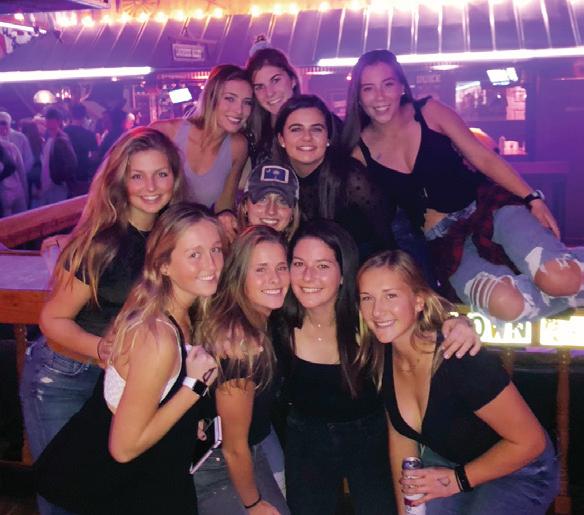
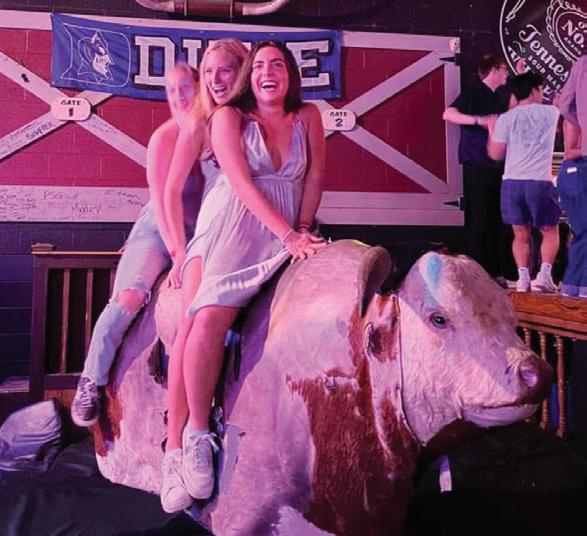






FROM PAGE 16
ever. Instead of letting that fall away to gamble on transfer stars, he’s using the portal to help his elite talent succeed. Scheyer said that he never guaranteed starting spots for Gillis, James or Brown when selling them his vision, instead guaranteeing that if they earn starting spots, they’ll get them.
Talk about sensible and sustainable.
“Our main way of building a team is still going to be through high school,” he said at ACC media day. “It’s got to be the right talent, right character, right makeup. I think the days of six and seven guys in a class, I don’t see that in our future … I definitely see at least four, but as long as it’s the right player.”
Duke got the “right players” — not just to cut the experience gap with other teams but to plug holes and provide answers.
If energy and scoring off the bench was a concern last year, Gillis — the reigning Big Ten Sixth Man of the Year and an elite perimeter threat — is the exact profile Scheyer needed. If defensive concerns in the post hurt Duke last year, Brown offers All-ACC Defensive Team talent. If Duke lacked leadership after three-year captain Jeremy Roach transferred to Baylor, James brings four years of starting experience in New Orleans.
I don’t mean to dig Young, Grandison, John and the other transfers Duke has brought in recently before by praising the new group so heavily. They played their roles well — letting Kyle Filipowski and Dereck Lively II rest without a scoring dropoff, providing tournament experience and a 3-point arm, adding more muscle in the post, etc.
Those three players are, however, Duke’s only transfers since the pandemic to play at least five minutes per game, and their combined scoring average in Durham sits at just 3.9 points. If that were one player, it would sit seventh, ninth and seventh, respectively, in the last three seasons’ scoring charts. Scheyer’s 2024-25 crop all played at least 20 minutes per game last season and averaged 10 points per game in that span. That’s not to mention their defensive abilities and tournament experience.
So while the idea of filling gaps isn’t new for Duke, the quality of its gap-fillers is. By providing a substantial scoring boost alongside 10 combined years of experience playing elite defense on competitive teams, the freshmen can feel less burdened to assume all offensive responsibilities and have help adjusting to the defensive demands of the college game.
With just three portal acquisitions, Scheyer simultaneously built out the roster, improved his defense, added experience and gave his freshman stars enough support to feel less pressure by themselves. Win, win, win, win.
Now is when I must concede that October is far too early to say Scheyer has a perfect roster or that he’ll win it all. But this is, without question, the most complete, deep Duke team I have seen in a long time. It’s not the runaway most talented, but it has addressed its gaps with players who have spent their whole college careers playing those exact roles.
That’s why I believe this tactic will stick. Scheyer’s focus on recruiting means he doesn’t need to win the transfer class rankings and can instead achieve balance with a few specific targets that fit his needs.
This year is a proof of concept for Duke’s new approach to roster construction. And if it’s as effective as I think it will be, feel free to shove Groundhog Day back into winter.
FROM PAGE 7
In the first half, before the triples avalanche, the Blue Devils honed in on drives to the basket. They shot just 2-for11 from downtown in that period — Knueppel landed none from outside — but made up for it with 56.5% shooting inside the arc. Flagg and Khaman Maluach split up Duke’s first eight points, using their enormous height advantages — 6-foot-9 and 7-foot-2, respectively — to push through Sun Devil defense and rack up points with a combination of layups, paint scores and a Malauch dunk.
a comfortable 37-21 position heading into the locker room.
This is a time to get back to the roots of the value of our program, which is about competing.
That dunk earned Duke its first points of the matchup in a serendipitous display of Blue Devil rookie talent: Flagg threw the ball to Knueppel, who sent it up to Maluach for a statement start just 15 seconds into the game.
“This is a time to get back to the roots of the value of our program, which is about competing,” Scheyer said. “It’s about being all-in and then going to earn what you want individually.”
Knueppel remained the only player Scheyer didn’t pull off the court in the first 10 minutes of play. In so short a time, this freshman has cemented himself into a critical role for this Blue Devil roster, playing both an assistive and a spotlight role. In his third half as a college player, he led the team in assists and tallied five rebounds, second only to the much taller Maluach.
The Harrisburg, N.C., native didn’t slow down in the second half, either. He put up two more triples to contribute to a 60% shooting clip and handed off three assists during the duration of the game, playing his part as an enabler for his teammates as much as a point guy himself. Even in mustardyellow shoes, Hurley is Hurley on the basketball court. His frustration was eminent as he watched his team miss the vast majority of its shots; the Sun Devils delivered only a 23.5% success rate on field goals in the first half of the game. The other Devils fared better, as Duke made good on 44.1% of its attempts, its points shared between a long catalog of players.
Hurley called it a “trainwreck.”
But he was also quick to say that this exhibition was about more than basketball. In the moments before the game began, Mike Krzyzewski walked onto the court to embrace Scheyer and Hurley together. The brand-new jumbotron played a highlight reel of Hurley’s best Duke moments, and his old coach rested his championship-ringed hand on his former player’s shoulder while they looked up at their shared memories.
“I know how much the Duke Children’s Hospital meant to Coach K when I played here, and what it now means to Jon,” Hurley said. “So it was a no-brainer for us to want to support that.”
“I’ve been a huge fan of his ever since I watched college basketball,” Scheyer said of Hurley. “To have that moment before the game with him and Coach K meant a lot to me.”
3.UConn (1345) 3.Wake Forest (800)
4. Houston (1343) 4.Clemson (765)
7. Duke (1154) 7.Pittsburgh (636)
8. Baylor (1109) 8.N.C. State (550)
9.North Carolina (1037) 9.Louisville (518)
(1449) 1.Duke (956) 6. Gonzaga (1157) 6.Miami (659) 11.Auburn (901)
5.Iowa State (1177) 5.Virginia (743) 10.Arizona (905) 10.Notre Dame (462)
(454)
12.Tennessee (775) 12.Georgia Tech (433)
13. Texas A&M (737) 13.SMU (344)
14.Purdue (678) 14.Virginia Tech (252)
15.Creighton (631) 15.Florida State (251)
(625)
19. Texas (332)
20. Cincinnati (271)
(249) 2.Alabama (1428)
(206)
17. Indiana (492) 17.Stanford (165) 22.UCLA (210)
18.Marquette (484) 18.Boston College (116) 23.Kentucky (191)
24. Ole Miss (132)
25. Rutgers (102)
Carolina (924) G RJ Davis (North Carolina) G Hunter Sallis (Wake Forest) G Nijel Pack (Miami)
G Markus Burton (Georgia Tech) F Cooper Flagg (Duke)
There’s a lot of fresh talent for the Cameron Crazies to be excited about, but there’s also a lot of credit to pay Proctor and sophomore Caleb Foster, the anchors of this star-powered roster. With a triple each, the pair put up 16 of Duke’s 37 firsthalf points. Foster led the Blue Devils with nine at the halftime buzzer, and his layup at the very end of the first period put Duke in
For Hurley, it was a homecoming and a chance to coach his son Bobby Hurley Jr., who proudly supported his dad’s No. 11. From the spectators to the players to Hurley and Scheyer, this exhibition was about taking advantage of sports in the best possible way — for the community.
